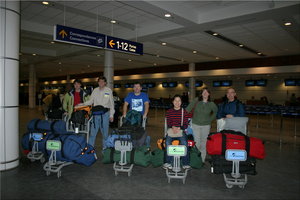
Here is the chronicle of a trip taken by Andrew, Caroline, Pu, Peter, Yi and myself in January 2005. The trip was, as always, capably organized by Andrew. This is my perspective on the whole thing. You can also read Andrew's writeup.

|
|
All set to go at the airport
|
Two large duffel bags are packed, as always. I have kept an obsessively detailed list of everything I am taking, so as not to forget anything. This is the biggest trip I've ever gone on, and I want to do it right.
Andrew shows up at noon to pick me up. Pu is picked up next, and we all meet at Andrew's house. We will drive to Montreal in his and Peter's cars, with Ewart and Peter's wife Martha driving the cars back.
No sooner at the airport, than there is a panic: Peter doesn't have his passport. Frantic phone calls are made - there is still time for the passport to be found and rushed to Montreal before our flight departs. But then he finds it in his jacket pocket. I'm thinking now we've had our glitch for this mission (no apologies to the Apollo 13 movie).
We have come early, so we sit around for several hours before our flight departs at 7:40pm.
British Airways takes pretty good care of its customers, and the food and service on the Boeing 777 plane are good. I watch a dumb movie on my personal video screen before sleeping for an hour or so.
Andrew uses an internet kiosk (with an awful all-steel keyboard) to post the first of his web updates. We go for a leg stretcher walk down the length of the terminal, which is huge. It seems like a kilometer-long shopping mall. This is a big airport.
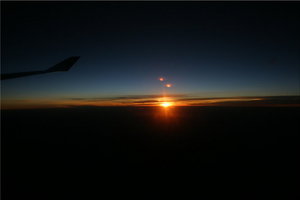
|
|
Sunset at 37,000 feet
|
The Sahara is big. Really big. You realize this when you look down and you see sand, nothing but sand, flying for two hours in a Boeing 747 at 850km/h at 37000 feet, and you look at the map display and realize that this strip of sand goes right across the whole continent. It's big. By the time we're finally starting to see green again, the sun is setting.
In the dark, we see brush fires - long, jagged strips of brilliant orange. At one point I see four or five of them at once. There are no other lights visible.
I go into a washroom and change into light synthetic clothing.
At Nairobi airport, we exit the huge airplane on old-fashioned stairways and walk across the tarmac to the terminal building. I realize that this is goodbye to our familiar civilization for a while. I don't know yet what to expect from this continent, where everyone is black and we white folks are a tiny, visible ethnic minority.
Naturally there is a huge delay until our baggage comes out on the carousel, and the flight itself was late as well. I wander out to look at the crowd waiting for the flight, and there is someone there holding up a sign saying "Andrew Lavigne". Good work, Andrew. I signal to the man that we are here and he signals back that he has seen me.
When we finally have our bags and have gone past the customs person without so much as a word spoken, we are bundled into a Toyota "Hi-Ace" minivan (I don't know yet just how common this type of vehicle is here). That's the driver and his assistant, all six of us and all of our bags. If you squeeze really hard, you can get the doors shut. At least one of us ends up sitting on luggage. Hakuna Matata - that's Kiswahili for "No Problem", and it describes the attitude of this whole country. The driver and his buddy chatter cheerfully as the rest of us gaze out the windows at this alien land, with its palm trees, with cars driving on the wrong side of the road, armed police checkpoints, and the warm humid atmosphere (back at home it is, of course, winter).
Thumping music and crowds greet us in Nairobi. It is New Year's Evening. We are decanted at the 680 Hotel, right downtown, and a swarm of bellhops / security types comes out and takes our bags inside. Speaking of the bags. Among much anecdotal information I received about Africa was that your bags would likely be stolen from. So I put those tiny travel padlocks on the zippers. No worries. The padlocks are still there.
The hotel takes cash. This turns out to be typical. Credit cards are only barely trusted in a sophisticated place like Nairobi, and everywhere else, wads of cash rule, local currency or U.S. dollars doesn't matter.
The turn of the new year finds us in our hotel rooms, and we toast each other with a little wine, and lean out the window to observe an impromptu parade of a fire truck or two and lots of cars with their horns honking. In the distance, some fireworks crackle.
Sleep would be nice after 36 hours of travel. But directly across the road is a very loud drinking establishment. The music they are playing sounds very African, even though I once recognize the tune from "Ay la Bamba", but played in the local style. I'm jetlagged and suffering sensory overload and can't sleep. So I go down to the hotel's internet access room, where for a measly 2 Kenyan shillings per minute (amounting to less than a dollar per half hour) I have the use of a Windows machine with instant messaging and everything. I make a phone call to my parents just to enjoy the novelty of calling across an 8 hour time difference. For them it is still 2004, and not even dark yet.
When I go back upstairs, I am greeted by the floor security guard. There are a lot of security guards here in Nairobi. They're like paid loiterers, they're always standing around, I guess to deter the unpaid and potentially troublesome regular loiterers. All have smart uniforms and none of them are armed. The real serious ones have a baton and maybe a pair of handcuffs. The only people here with guns are the cops and the military, and they don't fool around, they typically have assault rifles if they have anything.
I ask the floor security guard when the noise from the establishment across the road can be expected to stop. Oh, about daybreak he says. Great.
I must have fallen asleep eventually, because I am woken up by a loud clanking as workmen across the street dismantle the party emporium that made all the noise last night. We pull back the blackout curtain and get our first look at Nairobi in the beautiful morning sunlight. It looks like any big city from here, but the trees are different - acacias and palm trees.
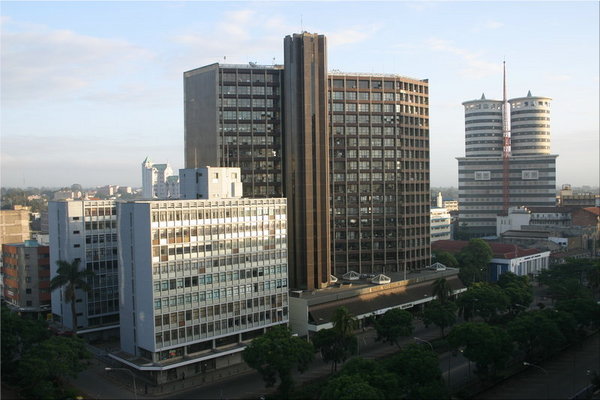
|
|
First look at Nairobi from the hotel window
|
I see no evidence of heating or air conditioning in our hotel room. And the window opens wide, you could fall right out or drop something, down eight floors and through the glass roof of the dining hall below. Even when the windows are closed, ventilation slots in the tops of the frames are still open. There are no mosquito screens. Nairobi is at about the same elevation as Denver, Colorado (5500 feet above sea level) and has no mosquitoes and a wonderful climate year round.
We go to the breakfast buffet. Large windows open onto the street from the second-floor hall, and leafy green trees are outside and the sun filters through, and I feel like I'm in a movie scene playing in, say, Saigon, Vietnam. After breakfast, I find that the doors to the outside stairway on the highrise hotel are now unlocked and wander up onto the roof. Nobody stops me.
We set out to explore the town. I don't take anything worth stealing, just a bit of cash in a money belt inside my pants. Everything else including the camera gear goes into the electronic safe in the hotel room. Some of the others take cameras, though.
We walk around, remarking on the invitable security guards loitering everywhere. Closed stores have heavily barred doors and windows, and one electronics store that does not has several guards standing around even though it is closed.
We eventually end up across the street from a large park. I need to go to the washroom, so I direct our steps into it. A troop of men in military fatigues (but without firearms) has recently marched the same way. I think they are patrolling the perimeter of the official compound that includes the highest court and the president's residence.
The park has seen better days. The grass is scruffy, garbage is everywhere, ignored barbed-wire barriers line the footpaths. It is still early, but already families are there having a holiday. There are a lot of people selling bottled soft drinks out of cases. I buy the first of many bottles of Fanta (an orange soft drink not sold in North America) that I will have on this continent. I find the washroom structure, and it charges 5 shillings (less than a dime!) admission. I gladly pay it and it is clean inside. We continue exploring the park, walking up a hillside to take in a view of downtown Nairobi. There is an impressive lily pond, a small lake where people are rowing around in rental boats, and an open air auditorium where workers are erecting a stage.
As white tourists, we attract about as much attention here as a bunch of Masai warriors would attract in Andrew Haydon Park back home in Ottawa. We are accosted a few times by people just wishing to say hello, or take a picture, or collecting for a supposed charity. But there are six of us, so we are not bothered much. Only later do we find out that this, Uhuru Park, is considered unsafe for tourists, so a group of six of them wandering around is an unfamiliar sight.
I keep smiling to myself as we walk around in this wonderful warm summer weather, thinking how cold it is back home and how we simply got on an airplane and opted out of winter. To me this is still a great novelty.
We go into another park, where there is a strange monument to Kenya's independence. Several men loiter around with books of photos, eager to explain the significance of the structure, for a fee of course. We brush them off and so we will never know the significance of the chicken motif on one side.
On the street, most vehicles are old and belch highly visible clouds of pollution.
As we continue walking, we see our first white people. Two blonde girls. Ultimately, over the course of the entire day, I will count 14 white people other than ourselves.
Many people call out "Jambo!" (Kiswahili for "Hello, how are you?"). At first we are suspicious. Do they want to sell us something? Pick our pockets? But we learn that people are just naturally friendly here. We get wished a happy new year more times than we can count.
We attract much less attention in the downtown shopping district, which is mostly closed. A nearby square is full of people, and a speaker is agitatedly shouting into a microphone. With all the echo I can't tell whether he is speaking accented English or Kiswahili. We do not go into the crowd, as we are still fearful of pickpockets and such. Pu later determines that the commotion is religious in nature.
A trio of uniformed police or military types marches by, one of them with a machine gun.
We try to figure out where the famously bombed U.S. Embassy was but can't find it, and don't ask any of the loitering security types, thinking that they'll just want money for such guidance. We have much to learn in this respect.
We visit an outdoor craft bazaar. Caroline and Yi buy lovely wraps. The rest of us reject advances from people wishing to sell us wood carvings, paintings, Masai beadwork and bracelets. The prices are very reasonable. Spirited haggling is the rule, and the final price ends up between $5 and $10, typically.
Two street musicians are making a very compelling sound with a drum, a water bottle with sand in it, and singing. I throw some change into the hat to have an excuse to hang around and listen. Andrew tries to covertly record them with his pocket voice recorder. These are the only buskers we see all day.
We have, by now, walked a large rectangle around our hotel, 1-2km on a side. On the way back to it, Caroline spies an Italian restaurant and wants to eat there.
The restaurant seems very authentic, in the style of the building, the menu and the food. They even bring bread sticks (but they blow it by having margarine instead of the olive oil and vinegar customary in northern Italy). The restaurant has a particularly well uniformed security guard, with military style chevrons on the shoulders and a beret on his head. At any rate, $50 worth of Kenyan shillings (no credit cards accepted) buys the six of us a pasta dish each, plus drinks, bread, bruschetta and copious attention from the waiter.
We wile away the rest of the afternoon in the hotel, except for Pu, who goes out again. If you are in the vicinity of the hotel, you are constantly solicited to go on safari. The safari vehicles, which are clean and modern, are parked nearby. One could negotiate a fee on the spot and be out photographing animals within the hour.
In the evening we eat at the Indian vegetarian buffet that the hotel has. It costs about $3.50 each and is quite good.
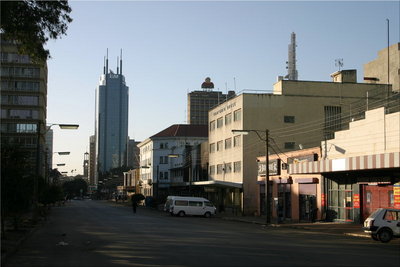
|
|
Nairobi, morning street scene
|
The Davanu shuttle bus is a 37 seater Mitsubishi, apparently direct from Japan (where they also drive on the left side of the road). At least, there are Japanese characters all over the switch gear. The speedometer permanently reads 28 km/h, the fuel gauge permanently reads "empty" and there is no evidence of actual cold air from the air conditioning. The tires are the same style of locally made all-terrain tires one sees on land rovers here. I'm not even sure they are radial tires. Otherwise, the bus is in good condition.
Driving through the suburbs, I remark on the slummy neighbourhoods and on the walls that surround anything of value. Sometimes the walls have glass shards or barbed wire on top. Many buildings look lived in, but to my view only half constructed, with unfinished brick walls, empty window openings and such. Streets are unpaved, and vehicles belch clouds of smoke.
We stop at the airport and then head into the countryside, after a couple of police checkpoints which always consist of some tire bursting spikes you need to steer around, one guy with a machine gun, and a couple of others who stop whatever vehicles they feel like. The cops wear military style berets and look scary, but the one time our bus is stopped, the driver has a cheerful 30 second conversation with the cop in Kiswahili, and then we are waved on.
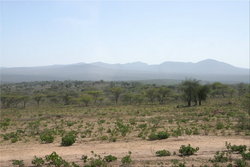
|
|
Typical southern Kenya countryside
|
Whenever there is a town, the road has big speed bumps. The cops don't need to go chasing speeders here. The towns are dusty, unpaved, with primitive shacks for buildings. To me they look depressingly poor.
Whatever else this area doesn't have, it does have cell phone service. We see the towers at irregular intervals.
Passing works differently here. It is done cooperatively. First the vehicle to be passed signals left (i.e. to the side of the road) to indicate that it is OK to pass, that the road is clear. Then our bus passes it leisurely, in much too high a gear (we will notice that driving at near engine stall speeds is almost universal here. 25km/h? Better shift into 4th). If someone is coming the other way, they slow down to make room. At any rate, nothing happens too fast, 80km/h is about the order of the day on the bumpy highway. There isn't much traffic at any rate, and what there is is mostly all-terrain vehicles and minibuses. We play tag with another big bus. Ours is full of white tourists. The other one is full of locals and stops frequently to take on or drop off passengers.
We stop at a "curio shop" where there are washrooms. The curio shop is huge, with thousands of pieces of local crafts. Some of the carvings are very nice, but in a 10-minute stop I would never buy anything. No prices are marked. I ask and I am told "it is between the buyer and the seller".
At the Tanzanian border, first we need to fill out exit declaration forms on the Kenyan side. Many people mill around the bus, trying to sell us things. I see some picturesque locals and aim my camera, and instantly a woman materializes by the bus window and asks for payment. Though the price drops from two dollars to 50 cents before I stop paying attention, I don't bother with the picture.
A little further on is the Tanzanian border compound. It has an iron fence all around, and openings just wide enough for one vehicle on either side. The bus squeezes through and parks. Other buses are already here, and border agents are on the roofs, looking at the bags. We file into the customs shack. I notice that they have Dell computers with flatscreen monitors in there, somewhat incongruous with the dust and the corrugated metal roofs outside. My passport is barely glanced at before my Tanzanian visa is multiply stamped. When I get back to the bus, the man who has been riding shotgun all along is on the roof, watching the bags. As far as I can tell they have not been disturbed. I'm beginning to understand why the bus has a staff of two: Either the driver or the other guy is always with it and guards it.
The landscape gets noticeably lusher as we gain altitude near Mount Meru. Ultimately the road reaches about 6000 feet, and this is a blessed altitude in these parts. The fields are lush and green. The simple villages, with no electricity or glass windows, and walls of locally made bricks, and thatched roofs, look tidy and pretty. The people are colourfully dressed and wave cheerfully. All this without motor vehicles or television or coca cola. I love it.
Then we descend into Arusha, which is leafy with banana trees, and stop at the Mount Meru Hotel. Two very serious looking guards man the gate. "Lock your doors", a sign reminds anyone driving out of the compound.
I seize the opportunity to climb onto the roof of the bus, to help sort out the bags since most of the passengers are getting off here. We continue on the highway east to Moshi. This highway resembles a large 2-digit Ontario highway back home, and it goes through fairly modern farms and settlements. Even an occasional modern glass office building does not look out of place here. A heap of clouds to the left completely hides Mt. Kilimanjaro. We will learn that this is normal for this time of day.
There is more traffic here, but still it is almost all utility vehicles. All-terrain vehicles from Suzuki Samurai to "Land Rover Defender" in size, minibuses, big buses, trucks. Perhaps one vehicle in 10 is an ordinary car. Perhaps 8 vehicles out of 10 are Toyotas; the rest are other Japanese brands, with the occasional Peugeot mixed in. And of course land rovers of all vintages.
We stop at Davanu headquarters and pick up a third staff member, who appears to outrank the driver and the copilot. Then the bus drops the passengers off at their hotels.
We are staying at the Springlands Hotel, which seems to cater exclusively to customers of Zara Tours, which has an office here. It is very fancy, and completely walled off from the outside. We are introduced to Chombo, our guide for the Kilimanjaro climb. The answers to many of our questions are vague - how much can we give to the porters to carry? Route details? Acclimatization days? Sleeping mats? It will be "organized" he says. No problem. Be ready at 8AM tomorrow.
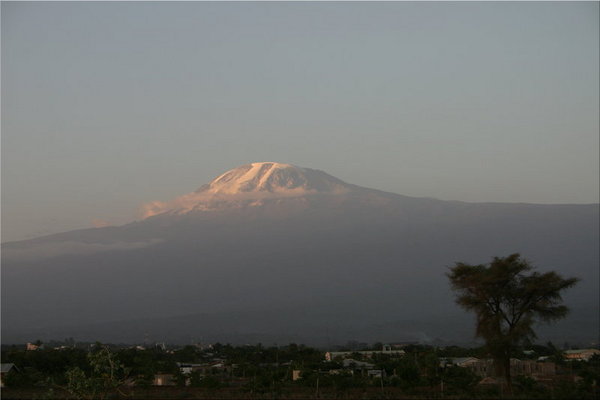
|
|
First look at Kilimanjaro, in the evening from Moshi
|
In the evening, I wander out the front gate, and... oh wow. Kilimanjaro has shed its clouds and is glowing in the sunset. I come right back with the camera. After I've got that picture, I take some of the compound from outside, but am quickly chased back inside by a guard, who explains that it is not safe to be out after dark. I make some sarcastic comments about getting back into the chicken house, but do so. In general, I feel a little bit rubbed the wrong way by this walled fortress with 100% white guests amidst a poor black neighbourhood.
The hotel has internet access via a wire dish antenna on the roof (the ISP is kilinet). It costs $1 for 15 minutes and so we catch up on our email.
Our beds have mosquito nets. We all took our first "Malarone" anti-malaria tablet at breakfast in Nairobi yesterday, and will continue to take these until 5 days after we return to Ottawa.
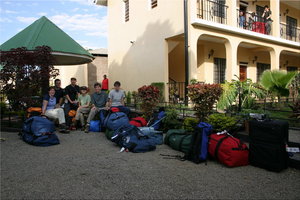
|
|
All set to go. But where is our ride?
|
The safari vehicles are cool. Toyota Land Cruisers and the occasional Land Rover Defender, festooned with iron bumpers, roof racks, diesel engines, snorkel air intakes, dual spare tires, manual transmissions, and ribbed sheet metal riveted to the hood to use as steps for loading things onto the roof. I remark that there ought to be a law that S.U.V. buyers back home in North America have to get a vehicle like this. That would fix 'em. No CD player, no air conditioning, no power windows, just real off-road utility.
Alas, none of these vehicles are for us. 8AM, 9AM, 10AM, and nobody is left except us, and we just get vague excuses.
Pu is depressed because he has caught a cold, his first one in 8 years. He and I walk over to a store near the hotel, drawing suprised glances from the people there. The store is just a barred window in a shack, with a girl handing out the purchased items. The man in front of us buys two cigarettes. They have cough medicine. It comes as foil packets of two tablets each, costing about 12 cents. It is not the right kind though.
A little after 11AM, a busload of porters is glimpsed, and then Chombo and some other guys show up in a Nissan minibus and we are finally on our way. I am worried now about our first day's climbing itinerary. We stop at Zara headquarters in town. Across the road, a large number of men are loitering against a wall. It turns out they are all hopeful for jobs as extra porters. Another stop to buy Pu's cough medicine, and then we go onto the road up the mountain.
The dirt road is incredibly rough, so rough that nothing less than a Humvee would be required for it back home. The driver skillfully but slowly navigates the 2-wheel-drive van through.
Everywhere, people are on bicycles. I notice that all the bicycles are the same. Yi says these are standard-issue Chinese bicycles.
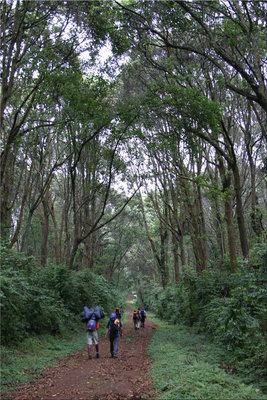
|
|
Beautiful jungle at about 6000 feet elevation on Kilimanjaro
|
The road is lined by small subsistence farms. An acre or two of banana trees, some coffee or corn maybe, a simple shack, usually with no electricity or glass windows. Footpaths lead to other farms farther from the road. Often these are not wide enough for a vehicle to pass.
As we bump along the road, going higher (the trailhead is at about 5400 feet) things seem to get gradually poorer, with drab, torn clothes replacing the colourful garbs earlier and kids looking less spirited. When we reach the trailhead itself, there are a group of men and a larger one of kids standing at a respectful distance, silently observing the supplies being unloaded like one of the wonders of the world. While porters sort out the loads and everyone signs in, I feel compelled to give them something, but what? I find three packets of chewing gum that I can spare. I unwrap them and, holding the 15 sticks of gum fanned out in one hand, approach the children. Do you like gum? The answer is obvious. I am stormed, the sticks of gum torn away from me with such ferocity that some kids get 2 or 3 and others get nothing. Caroline snaps pictures. The children don't say a word.
Pu wants to take a photo of some other kids, and borrows a 500 shilling note from me to give them. That's 50 cents. I'd like to know how far 50 cents can be stretched here. I suspect he just made someone's day.
Mike, who we will meet in two days, cynically says this pathetic display is an act, that they know exactly how to look and dress and act to maximize handouts. Indeed, when I later look at the photo that Caroline took, I notice one of the poor kids is wearing a wristwatch.
We get our bag lunch for the day and are sent ahead with one of the porters, whose name is Shebe, and who speaks good English. Walking on a trail with a pack feels familiar. The trail is initially a vehicle track through lush jungle, with giant ferns and tall trees. The woods are beautiful and virtually free of mosquitoes. Shebe has a children's school knapsack, a 250ml water bottle, and carries one of our large duffel bags, with some sleeping mats lashed onto it, alternately on his head and on the back of his neck with his head bent forward.
After an hour or two, we stop to eat the packed lunch. Because we are so late, it takes us until nightfall to reach the night's camp site, Umbwe Cave (we don't actually see the cave), and by that time we are ahead of even Shebe, with his heavy load. Chombo and the porters trickle in after it has become fully dark and they are badly equipped for this, with few headlamps or flashlights. Even so, they serve up dinner with all the trimmings.
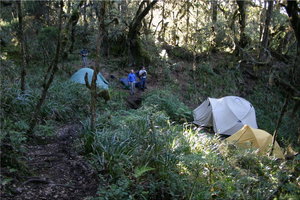
|
|
Umbwe Cave Campsite. Level tent sites are in short supply here.
|
The standard pattern is that we pack up our daypacks and our porter bags (i.e. our sleeping bag and air mattress) and leave the tent standing and just start our hike with Chombo. The crew will collapse our tents, and pack up the whole camp, and then pass us on the way up, to prepare camp again before we arrive.
Breakfast and dinner are served in multiple courses with a clean tablecloth and a candle (if it is dark). Breakfast typically consists of porridge, fruit, hot dogs, fried eggs, and toast. Dinner typically consists of a soup first course, often with chapati (thin pancakes, exactly like the Flädle made in southern Germany), then a carbohydrate main course (rice, potatoes or spaghetti) with a meat or vegetable stew, coleslaw and perhaps a piece of chicken each. Dessert is invariably fruit. For drinkables, hot water along with milk powder, cocoa powder, instant coffee and tea bags is supplied. Sometimes we get a trail lunch with typically a boiled egg, a piece of chicken, a buttered roll, a small bag of peanuts, a piece of cake or two cookies, a banana (the local variety which is about 5 inches long) and an orange (the local variety which has a dark green outer skin). Sometimes when we are in camp, we get an afternoon snack, which is popcorn and digestive biscuits. We carry our own supplemental "comfort foods" such as granola bars, chocolate and candy.
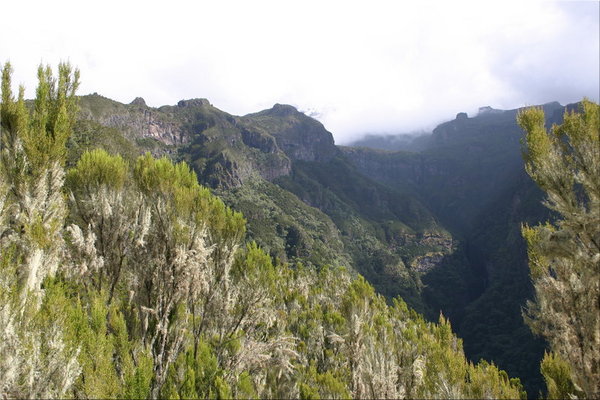
|
|
Barranco Gorge from the trail
|
In the morning, we are brought bowls of warm water for washing. For drinking water, we leave our empty bottles with them in the evening, and they are brought to us in the morning filled with boiled (but now cool) water. We have brought our own flavourings such as Tang and Gatorade.
The porters have generally poor footwear and clothing, and they carry their heavy loads mostly on their heads. Chombo has a proper backpack and carries all his own stuff; even so, I notice he does not use the waist belt that would transfer most of the load to the hip bones, as we ourselves prefer. In general, whenever a guide or porter has a good piece of gear, it has been donated by a generous client in the past.
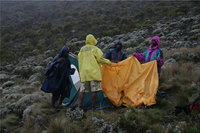
|
|
Porters setting up one of our tents in the rain
|
After a hard and seemingly endless climb, we finally reach the Barranco Hut campsite at 13,000 feet elevation and in the fog and drizzle our tents are quickly set up for us. I soon discover what a mistake it was not to bring my paperback books, or one of those $2 earbud radios from the dollar store back home: The afternoons and evenings, cowering inside your tent out of the rain, are BORING.
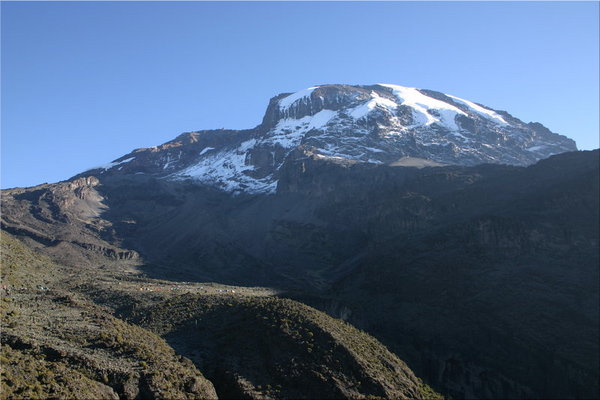
|
|
Barranco camp site from a distance
|
This is the highest I've ever camped at, and I feel fine. No headaches, no dizziness, and at rest I can breathe comfortably slowly. But I can't eat. In the night I threw up all of dinner, and at breakfast I feel queasy and can't eat much. I blame this on the altitude. Also, I am instantly out of breath if I exert myself.
We meet Roman, who is from Munich, Germany, and Mike, who is from Calgary. Both are doing solo expeditions, i.e. just themselves and two porters and a guide. Mike is spending a year in Africa after graduating from university.
I also talk to a pair of experienced Austrian climbers, who, like us, intended to go up the Western Breach - a daunting looking, mostly snow-covered 30° slope seen from here in profile on the southwest side of the mountain. There is talk that it has snow and ice on the trail, and that they would do it if, like us, they had brought ice axes and crampons. But since they didn't, they will go east to ascend from Barafu camp instead (where we will descend). Our guide Chombo will also try to dissuade us from going up that way, but Andrew sticks to his plan.
Before lunch, we do an acclimatization hike up the next part of the trail. Chombo immediately assigns us a pair of minders. The trails here are not marked well and not signed at all. It is expected that you don't walk anywhere without a guide. Our two minders would like to take us around a loop, but it is not clear how long the loop is, and when we reach 14,000 feet and it starts to rain ice pellets, we turn around. In the course of this hike, all of us except Andrew have set new elevation records for ourselves.
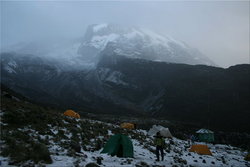
|
|
After the deluge
|
After dinner, the deluge stops, the clouds clear and the scenery looks greatly modified. Chombo says that we are lucky to see snow here. I just laugh and tell him about the kind of snow we see at home at this time of year. Several streams rush through the camp site, but fortunately all bypass our tents. Caroline and Yi's tent has become wet inside though. We give them our overbags to use inside their damp sleeping bags.
I marvel at how cheerful and unaffected the porters seem to be in their light clothing. In particular, Luckas is still wearing just shorts and a light shirt!
After breakfast, we pack up our porter bags and swiftly commence our hike with Chombo.
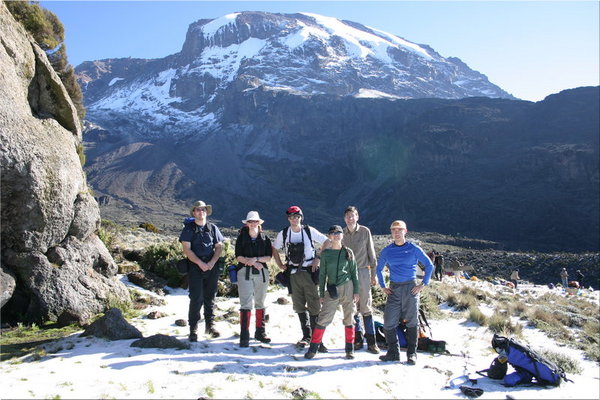
|
|
All set for the hike from Barranco Hut to the Lava Tower
|
We initially hike with Mike and his guide, but they are faster and go on ahead after the first hour or so. Roman is no longer with us, since he did not take a rest day at Barranco and went up yesterday.
I feel fine until about 14,000 feet (as high as we went yesterday) but then the altitude gets to me again, and I am breathing heavily and walking slowly even though it is less steep. Caroline gives me a "power gel" which is only 100 calories, but helps because I can keep it down.
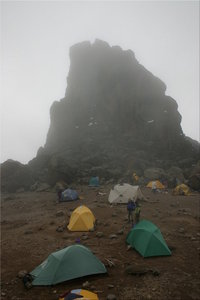
|
|
Lava Tower encampment
|
We are in a lifeless landscape of brown earth and rocks. In some places, not a speck of vegetation is visible anywhere. The air is thin. Several people have altitude headaches. Andrew is teaching us "pressure breathing" where you exhale through tightly pursed lips, to increase the air pressure and therefore the oxygen absorption in your lungs.
After a long walk, the lava tower emerges from the murk. We are at 15,000 feet, but heartbreakingly, we have to go down into a deep gorge and back up on the other side before we reach camp. Though the timestamps of the digital photos reveal that it took half an hour to cross it, it seemed longer. And then, blessedly, we have arrived. Tents are already up, and on level ground too. Among the scattered supplies, I see an emergency oxygen kit.
After lunch, of which I manage to eat a small amount, Andrew and I go walking a little way down the trail toward the Shira Plateau, where we see another tent encampment in the distance. Pu, Peter and Mike join us.
I still don't have an altitude headache. We are at 15,200 feet, and theories abound how best to cope with this. One says that you should minimize your time at such an altitude and continue right up the mountain the next day. Another says that you should take lots of time to acclimatize (which we are doing - rest day tomorrow). Some say you should take Diamox as a preventative measure, others say you should only take it when you really need it.
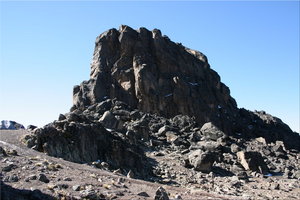
|
|
Lava Tower from northwest. The easy way up is around the right side.
|
Around 11pm, I woke up with my first serious altitude headache, and took my first Diamox, as well as two Ibuprofens, safely away from the tent until sure that my stomach wouldn't reject them. The headache went away, and I slept well, other than the time spent lying awake because the night is simply longer than you can sleep.
While up for a pee break in the night, I looked up at the mountain, darkly silhouetted against the starlight, and saw a few specks of light low on the western breach, each a group of climbers starting their summit push with their headlamps. Later in the night, I looked up again, and the specks that remained were much higher, the missing one having presumably reached the rim and gone out of sight.
The sun rose at 6:30AM but it takes until 8AM for it to reach us over the summit, and until about 10AM for the clouds to start enveloping the mountain.
I get out of the tent when the sun hits it. Of breakfast, I manage to eat one slice of toast with margarine and honey, and a power gel given to me by Caroline. While we eat, we notice that Mike has climbed to the top of the lava tower by himself.
A group packs up and leaves. From Mike we know that they intend to camp in the crater itself, at about 18,700 feet. Chombo says you need to pay extra for that and get specially qualified and equipped porters. Our own porters will go no higher than Arrow Glacier Camp at 16,100 feet, then go back down and meet us after we've done the summit. I wonder whether it is even possible to sleep in such rarefied air. We will later hear that in the night of January 8-9, a man actually died while camped in the crater, as a result of diarrhea and altitude sickness.
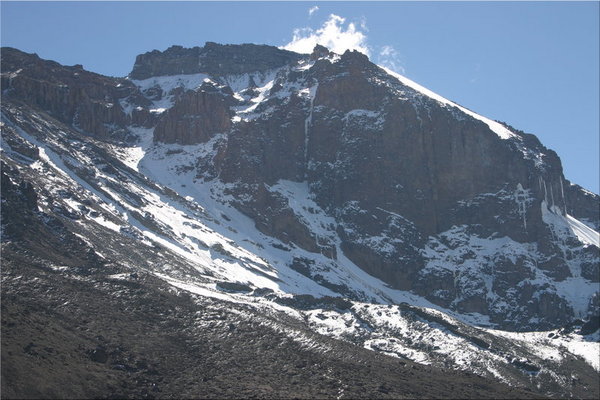
|
|
Western Breach and summit, seen from the Lava Tower. The Arrow Glacier Camp is on the ledge near bottom center. |
After breakfast, we all climb the lava tower. There are only about 10m of hands-and-feet climbing involved, the rest is trivial. Going around to the front, you can look almost straight down at the campsite, and there is an excellent view of the upper mountain. Chombo and another guide have accompanied us.
The camp site is a natural fortress. On the east and west sides, there are dropoffs and you walk into the camp through gates in natural rock walls. On the south side, the lava tower rises, and on the north is another rock wall. Enclosed is a flat area with lots of good tent sites.
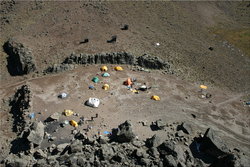
|
|
Camp site from the top of the Lava Tower
|
Back at the camp, in the ice pellet shower, there is little to do other than snuggle in your sleeping bag and occasionally whack the roof to knock the accumulated ice pellets off. While we do this, there are construction sounds next to our tent. When the shower stops and we get out, a large house tent and another cone-shaped tent have gone up next to ours. The occupants of the house tent are two girls named Courtney and Julia. They are from British Columbia and have just finished med school, and came up via the Shira Plateau and intend on the same summit schedule as us from here on. We will see them off-and-on over the next six days.
In the night, I once again watch specks of light in the Western Breach. Another 24 hours and one of those specks will be us.
We assemble our packs, and watch the porters break camp as everyone gets ready to hike up the trail with Chombo and Luckas. We reach Arrow Glacier campsite just as the clouds roll in for the day.
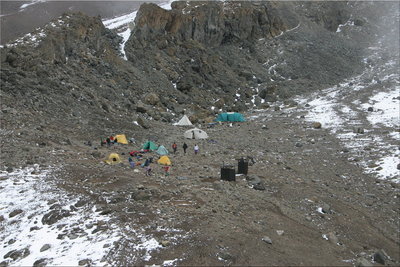
|
|
This is looking pretty hardcore: Arrow Glacier campsite seen from a nearby pinnacle
|
I am still using my heavy, rubberized cloth air mattress. I've had to combine it with the foam sleeping mats supplied by Zara for warmth because by itself it does not insulate against cold. I have no pump, and at sea level it takes me about 75 deep breaths to fully inflate it. There had been a debate about the wisdom of bringing this into such thin air, where breathing is hard enough as it is. Fear unfounded. It still takes 75 breaths and less than 10 minutes to blow up.
Tea is served, on the card table and chairs carried all the way up here on porters' heads for this purpose. I skip, for the usual reason.
I am breathing comfortably here at 16,100 feet, but get out of breath if I walk uphill at all. I wonder about anaerobic performance. Is it affected? To test, I sprint uphill until my strength runs out, and it seems normal. Only one problem, such an exertion renders you out of breath at sea level. Here I cannot get enough oxygen even desperately gasping, and my chest starts to hurt and I think oh no, I'm going to faint in a second. But some pressure breathing (exhaling through pursed lips) helps me recover. This is a bit frightening. Andrew and Peter think it is a hilarious, classic Markus maneuver, and would I please repeat it for the video camera? Sorry. A plaque on the rock where I ran out of breath says that an American died here in 1972. Cause of death not given.
A man is making the rounds, comparing notes. He is from Greece, and has already summited Mt. Kenya a few days earlier, and laments how slow his guide and his climbing buddy (who he met here in Africa) are. He would prefer to do the whole of Kilimanjaro at his own pace and without a guide. I wonder how fast he will be. He certainly seems to have no altitude problems.
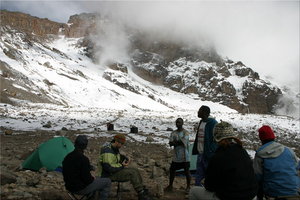
|
|
Pre-summit briefing against an impressive backdrop
|
Then we assemble our summit packs. For Andrew and me this involves going through all our stuff and making "take" and "leave" piles. The summit packs end up fairly heavy because of all the warm clothing, water, and the ice axe and crampons. My confidence comes and goes; one moment this whole thing just scares me, the next moment I feel "bring it on!".
I run out of water around 3pm, and don't successfully communicate to our support staff that I need more (they supply all drinking water, boiled for safety and then cooled). So I don't end up drinking anything before bedtime, which is before it gets dark because we will get woken up at 11pm. Sleep does not come right away because others in the camp site don't go to bed so early and continue talking. I do eventually get a few hours. I have taken a Diamox prophylactically and will take another one the next day, on the assumption that they help me.
At midnight, we start up the slope. I'm feeling pretty weak but Chombo sets a very slow pace that everyone can keep up with. It is pitch dark with no moon. We zigzag up a steep rock slope, for hours, with only the lights of Moshi far below to show us how high we are, but no real sense of how far we've come since we started today.
A snow slope needs to be crossed. It is very steep and though it has a clearly stomped boot track going across (Chombo has no trouble finding the way in the dark, even when no trail is evident to me), we get our ice axes out. I try to demo what to do if you fall and start sliding. It is my opinion that lesson #1 is how to do this and not to let go of your ice axe, ever. More experienced mountaineers Peter and Andrew, however, think lesson #1 is the "self belay" technique where you use your ice axe as a walking stick and anchor. The less experienced mountaineers draw their own conclusions and strap on their crampons.
With spiky metallic assistance, we ascend several steep icy bits, but after about an hour the use of ice axe and crampons is concluded for the ascent.
The climb is already the hardest thing I have ever done. I am dehydrated, my stomach is empty, my whole body is tired, and it is barely possible to get enough breath to walk slowly. I want to go near the front to set the pace for the group; instead I am sent ahead with Luckas, who has so far walked off-trail near us. As we continue, the others are a steady distance behind Luckas and me, indicating that our paces are matched, for the moment.
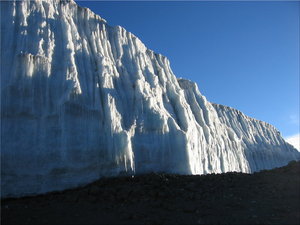
|
|
The ice wall (photo by Caroline)
|
After an endless climb (really, after about 4.5 hours) we appear to be at the top of the 30° slope and into what looked like a "head wall" below, because it gets steeper and more technical. Chombo calls this the "rock practice area". There is no hint of a marked trail, but Luckas always knows where to go next.
Luckas's pack has been making clinking noises, and as daylight comes and we stop for a break at a sheltered spot, he breaks out the glass mugs and the big thermos and offers tea. This is right where Courtney and Julia catch up.
It takes an almost superhuman effort to put one's pack back on and continue. We are now over 18,000 feet, and it looks like we'll be over the rim any second. But this is not so. The trail goes up and up, and every rock ledge that should have been the rim just reveals more when it is passed. I am getting slower and slower, having to take a long breather break every five to ten steps. And suddenly, all the energy and willpower are completely gone and I sit down and say that I can't go on any more.
But go on I must. Chombo and the others have gone ahead, and Andrew is impatiently shouting for me to catch up. Luckas takes my pack. I drag myself to my feet and continue, infinitely slowly. Another stop, where Luckas helps me put on every stitch of warm clothing in my pack and to eat a little chocolate and drink a little liquid and another ten steps and another break and another five steps and another rest and... finally, the sun hits us as we have reached the crater level.
A glittering white wall of ice is here. The summit block glows in the sunrise. Behind us, down an incredibly steep slope, far, far below, we can see the lava tower. And while the sun was rising, we could see the triangular shadow of Mt. Kilimanjaro in the haze to the west. These are some of the greatest photos I could take in my life, but altitude sickness is such that you just don't care any more except for a vague hope that someone else will do it.
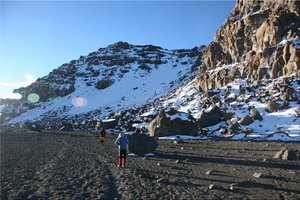
|
|
The summit, seen from the crater floor camping area (photo by Andrew)
|
Even walking on level ground takes almost more willpower than I have, and when I see that there is significant uphill to Stella Point, where we will cross the rim and start going down, I almost cry, or maybe I do. I throw myself in the snow, content to lie there until... fortunately, I am not alone, Luckas pulls me back to my feet and on we go.
Even when we have crossed the rim and are heading downhill, the walk is still very hard, and I am still wearing enough clothing to, ordinarily, handle -25°C temperature while the sun hits me with full force and the temperature rises above 0°C.
Incredibly far below, Barafu Camp is visible at 15,000 feet. Also we can see the highest hut of the Marangu ("Coca Cola") route which goes up on this side. I slog downward. Luckas patiently waits every time I sit down for a break. My camera bag is attached to the waist belt of the pack he is carrying for me, and it gets dragged through the dust a few times and I'm still too out of it to care. Also, I don't remember to put on any sunscreen. But as we go lower, I feel stronger. The weather is absolutely glorious, and ahead of us, Mawenzi Peak rises ruggedly.
It takes a long time to get to Barafu. 15,000 feet, which felt so high on the way up, now feels like practically off the mountain. I start to feel much better and actually envying the others who, presumably, are standing on the summit now. As soon as we arrive at the camp, someone comes over and pours us each a glass of pineapple juice - another Zara group is here and Luckas knows them.
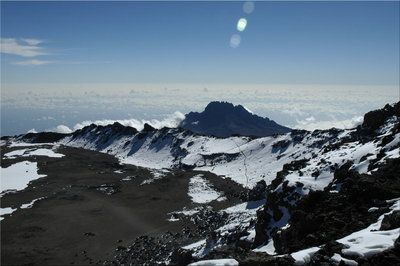
|
|
The trail over Stella Point, as high as I got. Mawenzi Peak in the background (photo by Pu, taken from near the summit)
|
Luckas goes back up the mountain to help the others. When they all come down, he is carrying someone's pack. If this man has any physical limits, I have yet to see them.
The other Zara group's cook provides soup for everyone but I decline. I may feel a lot better, but my stomach doesn't. Everyone agrees that the climb today was the hardest thing they ever did, and in particular, the last 600 feet to the summit alone was the hardest thing they ever did, taking two hours.
And we are not finished. A long hike awaits us down the Mweka route. Having already descended 4000 feet from the top of the mountain, we must descend another 4000 until we reach Mweka camp. So we walk, initially through a landscape so devoid of life, with only sand and rocks as far as the eye can see, that several people independently think that all you'd have to do is change the sky to orange and you could fake a Mars mission here. Further down, small shrubs make an appearance.
At Millennium Camp, we take a break, and watch a very large and cheerful Swiss group avail themselves of the Kilimanjaro beer that is for sale here (in glass bottles, all hand-carried up here). Right after this camp, the small shrubs change to large tree-like ones, and the vegetation gets lusher, and we can hear insects and birds and feel humidity and smell actual earthy smells when we inhale the ever more plentiful oxygen molecules.
The trail gets steeper, and another two hours elapse before we reach the blessed Mweka Camp at 11,000 feet. It is right at a point where the shrubby forest changes to proper hardwood jungle, and clearings have grass in them.
Mweka Camp is like an American car campground, except there are no cars. It is large and lively. We have to sign the trail register here (we will sign out again at the end of the hike). Our tents are already up, on not particularly level ground but I don't care. The whole early part of the day is kind of hazy for me, and I have to force myself to realize that I gained almost 3,000 feet and lost 8,000 feet since getting up 18 hours ago.
I am inspired to put my voice recorder into hi-fi mode and walk through the camp to record the sound panorama. As I do so, I see the sunlit summit of Kilimanjaro over the trees and go back to get my camera.
Today is the ceremonial handover of the tip and the gifts. We have combined both for Chombo to distribute as appropriate. He knows all the porters and their needs, and who would best benefit from some BIC pens, or chewing gum, or a pair of mitts or a digital watch or any of the other stuff in our accumulated loot. The tip for our crew of 15 people amounts to hundreds of dollars and it is money well spent, since, from what we've heard, it essentially doubles everyone's take-home pay.
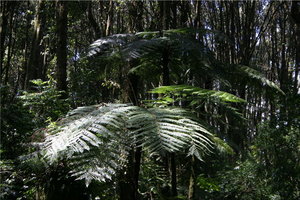
|
|
Giant fern in the jungle
|
Breakfast is eaten in the mess tent - the usual menu, with the difference that it already tastes better to me. The lower altitude has restored my appetite and calmed my stomach. We pack up our own tents, rather than leaving this for the porters to do, to ensure that all the pieces are accounted for.
Then we set off, accompanied as on the first day by Shebe. The Mweka camp is right at a boundary where the scrawny trees give way to lush jungle, and so the walk is very beautiful. Many times, we stop to admire giant ferns or sunlit clearings, or listen to the birds singing. There are no mosquitoes to speak of.
The trail continues relentlessly downhill. Yi has an old knee problem that has flared up, and is making her way slowly and painfully. Chombo and Luckas catch up and offer to help - it would be best if Yi just rode on Luckas's shoulders but she'll have none of it (I'd probably be the same in her shoes). The endless downhill is enough to make anyone sore - my calf muscles are complaining too. In total, we will lose about 5500 feet of elevation in 3 hours' walk today.
We are continually passed by groups of porters including our own. Nobody at all is hiking up this trail.
I fall behind so I have quiet to record bird noises (short sample, 362KB MP3). One of my recordings is spoiled by a guy and his guide coming down the trail singing. I strike up a conversation and meet Vinh, a newly minted Ph.D. in microbiology from UC Davis, who among other talents speaks fluent German. We have fun conversing in that language for a while.
Eventually everyone but Yi and Peter has gone ahead and I am hiking with Luckas. It is difficult to make conversation because Luckas knows little English. In other respects he is ready to be a full guide, so I hope he will learn.
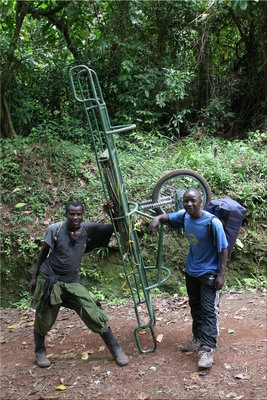
|
|
The stretcher carrier guy and Luckas
|
Just before the trail ends I see some women and children working. One of them is skinning a log with a machete. I don't bother with pictures this time, but again it is tempting to tip them something. I'm starting to understand that doing something interesting in view of wealthy tourists can be quite profitable by local standards.
And then we are finished. The large Swiss group is at the trailhead, being treated to grilled sausages, cold cut platters, cake and other wonderful food, and their touring company has large vehicles standing by. Our own company's bus couldn't make it up the last part of the road, which is too rough and steep, and we have to walk another 10 minutes. First though, Chombo hands out the certificates. Five of them say congratulations on summiting Kilimanjaro. Mine is the "nice try" version that congratulates the recipient for reaching Gillman's Point on the rim (actually I reached Stella point, which is higher, but Gillman's Point is the early turnaround on the Marangu route).
On the walk down, we pass very nice banana plantations, with the space between the banana trees filled in either with coffee or with corn. Children peek out between the stalks, and some follow us on the road.
Local commercial interests try to sell us knives, banana leaf pictures, bracelets and carvings. One of them tells me confidentially that he will take dollars or sh*t (Is he serious our a police plant? I don't care because I don't have any. Perhaps the leftover supplies of many climbers include a little weed). Bags are loaded onto the bus, speeches are made, the Kilimanjaro song is sung (I fail to record it because I didn't get the recorder ready in time), and then everyone gets on the bus and we're off.
Around 5500 feet, the landscape is lush and green and the small plantations look healthy. As you descend, the landscape becomes drier, and more conventional large-scale farms (mostly coffee) pass by. Children watching the bus go by shout "Chocolate?" I don't have any, but have some leftover hard candies (Werther's and Campinos) so I toss a few of those. I am later criticized for being culturally insensitive for doing this and stop.
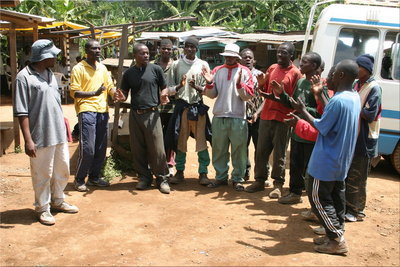
|
|
Goodbye ceremonies: Porters, cook and guides singing the Kilimanjaro song
|
Back at the Springlands Hotel, the first order of business is our first showers in 8 days. First we have to wait for the hot water heater to warm up. Though otherwise cleaned up now, I have badly sunburned my nose and lips, which are starting to crack and peel. Otherwise I'm fine.
We fill out a feedback form for the touring company, recharge digital camera batteries, fail to use the internet (because the connection is down -- half the computers are out of service anyway, these people need a good geek) and hang around drinking pop until dinner time. I wash two pairs of rad pants and a t-shirt in the sink with hand soap and hang them up to dry (this is the only laundry I do on the whole trip).
Peter spends time with the Zara travel agent and comes up with perfectly timed flights to use up all our unplanned time at the end of the trip by going to Zanzibar. But the flights are expensive: US $328 per person, from Arusha airport to Zanzibar and then from there to Nairobi to meet our flight home. Can this possibly be worth just under 3 days in Zanzibar? Especially for me, who has not been looking forward to going there for the last six months, and knows essentially nothing about the island? Pu doesn't think so, and makes other plans. I think about it and, well, you only live once, when is the next time I'm likely to be here and anyway we'll get to experience a real African airline. So I sign on.
Dinnertime rolls around. I'm not too enthusiastic about today's menu, which is lamb and fish. But as soon as I taste some, my long-absent appetite kicks into high gear and I devour two plates full of food, and it all tastes great. We expected a visit from Chombo in the evening, but instead Shebe and another guide come, to explain that Chombo had "an emergency" and is going right back up the mountain tomorrow morning. I give Shebe the two paperback novels that I brought, because he can use reading material to improve his English skills. I notice that these guys need visitor badges to get inside the hotel grounds.
We are checked out of the hotel and ready to go by 9:30AM. Our pickup is late though. Andrew is surfing Expedia and another travel site on the hotel's internet access machines, looking for a better deal on air travel. Not only does he not find a better deal, he finds no flights at all. The reason may be that most of them go to Kilimanjaro International Airport, and not Arusha Airport. So Peter attempts to pay for the tickets using a credit card. This is rejected and so are the other cards we have on hand (Visa, Mastercard, Amex). There is absolutely no way to pay for these tickets except to go to a cash machine in downtown Moshi, withdraw cash using our bank cards, and then go to the Zara office and pay in person.
Our ride comes. The vehicles are a Land Rover "Defender" driven by Robinson, and a Toyota Land Cruiser of similar size driven by Issa. Our cook's name is David. Vinh (whom I met yesterday) has been added to our safari party. A couple of other Americans are also riding along but will be going their separate way later today. All our bags are strapped onto the roofs of the vehicles as usual. I notice that the vehicles have two-way radios. We will learn that they have a private Zara frequency and that the radios have a usable range of about 150 kilometres.
We stop at the Zara headquarters where a trailer is attached to the land rover and then into town, where we drive around quite a bit before we all converge on the bank downtown. The bank has several serious looking (but as usual unarmed) security guards watching from across the road, and another in the lobby. It is air conditioned and just like any bank back home.
The cash machine will only dispense Tanzanian shillings and the largest denomination is a Tsh 5000 bill, i.e. worth US $5 or so (the official exchange rate is around 1050, the unofficial one used in the street is 1000). The machine also has a per-transaction limit of Tsh 200,000 and of course there are cash limits on our accounts. And Andrew's card is rejected. What this means is that between the lot of us we barely come up with enough shillings (in 1/4" thick wads; I should have gotten a photo) to combine with almost all our remaining US dollars to pay for everyone's ticket. It takes a lot of time and nerves fray a little before the tickets are finally bought and we are on our way westward towards Arusha.
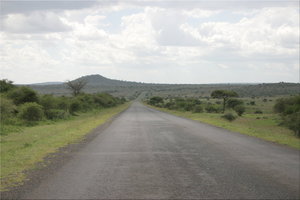
|
|
Wide-open Masai cow country west of Arusha
|
The Toyota has gone ahead but we pass it in Arusha. We meet at a big curio shop emporium just past that city and boxed lunches, very similar in composition to the packed lunches we got on the mountain, are handed out. To go with them, I buy some "Mirinda" brand soft drinks, a Pepsi product that I don't see anywhere else (Coca Cola rules as supreme as Toyota in these parts).
Andrew has a hankerin' for potato chips. But these are a rarity here. I go across the street to a well-stocked snack shop by a gas station and they have cookies and candy of every kind but no potato chips. An American from another safari tour who is also stopped for lunch waves an unlabeled clear plastic bag of potato chips that he bought earlier in the day for $3 and offers to resell it, but Andrew declines.
As we drive on, we soon turn right onto the road that goes up to Ngorongoro Crater. It is newly paved and in perfect condition. This sign photographed by Pu explains why such a nice road is here, in a relatively low-traffic corridor. We are in Masai country. As far as the eye can see, only open pasture, with herds of livestock each tended to by a colourfully robed herder. Sometimes the herders are children. Villages of mud huts, and sometimes more modern buildings, are visible in the countryside. Robinson explains that the Masai do not like to be photographed (except by prior agreement and with payment) so if one does it, please only from a fast-moving vehicle because otherwise they may throw rocks at the car. Also, we pass a military base, where photography is forbidden. I notice that part of the barbed wire perimeter fence of the compound is missing; only the concrete poles are there.
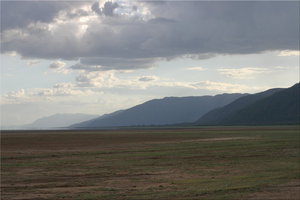
|
|
Great Rift, escarpment in Lake Manyara National Park
|
Lake Manyara National Park is a strip of land between the lake, and an escarpment that separates the flat park from the hilly terrain of the Great Rift which formed when a crack in the tectonic plate nearly split Africa in two, about 35 million years ago. The park has a variety of terrain and vegetation, from open grassland, to marsh, to dense jungle. It is criss-crossed by a network of dirt roads, most of them good enough for an ordinary automobile, but with a few water crossings worthy of a land rover type vehicle.
Almost immediately after entering the park and waiting for Robinson to complete some paperwork at the ranger station, we encounter our first (to us) exotic animals: Baboons. The engine is shut off and the cameras click away as the monkeys go about their antics. A little down the road, we see our first elephant, a small one (Robinson estimates 12 years old). Then another elephant, and then giraffes. We have by now left the woods and are out in an open plain (with other safari vehicles driving around in the distance). The giraffes standing about prompt Andrew to say that this must be where George Lucas got some of his visual inspiration.
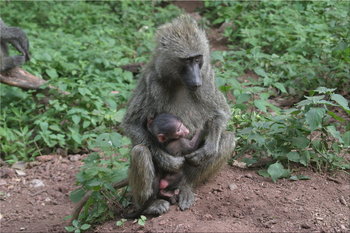 |
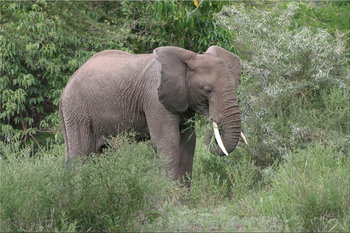 |
| Baboon mother and baby | Elephant eating grass |
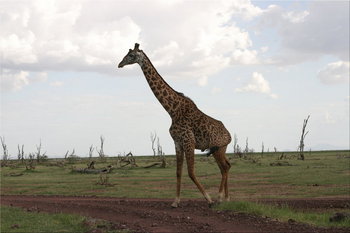 |
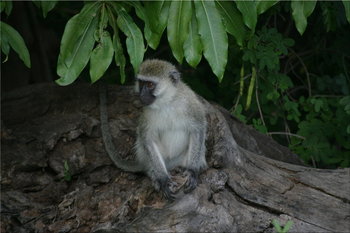 |
| Giraffe | Velvet monkey |
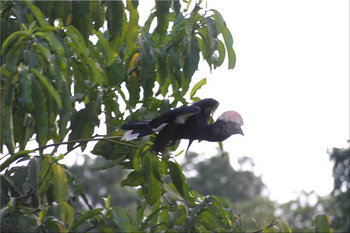 |
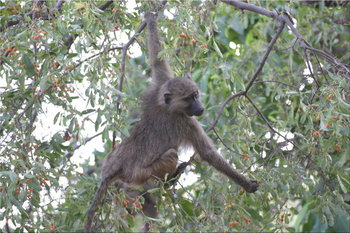 |
| Silvery-cheeked hornbill taking flight | Baboon picking berries |
The evening sunlight is beautiful, and so are the woods and open plains. We see a shimmering pink line on the horizon at the lake. We are told that these are all pink flamingoes. This seems hard to believe until a cloud of them obligingly flies up before settling back down. Pink flamingoes get their characteristic colour from their food, which is the brine shrimp that are easy pickings at the edges of shallow, saline lakes like this one.
A herd of impalas is encountered next. These are sleek, deer-like animals, with big horns on the males and none of the females. A given male has a whole herd of females. These creatures are totally unlike the heavy, cumbersome Chevrolet Impala automobile.
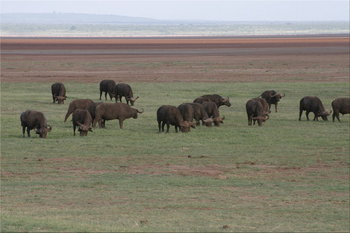 |
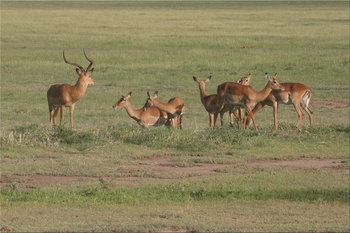 |
| Water buffaloes. On the horizon are thousands of flamingoes! |
Male and several female impalas |
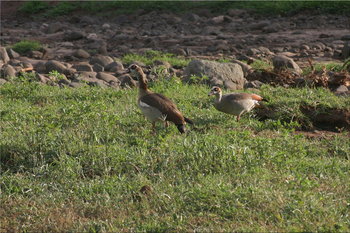 |
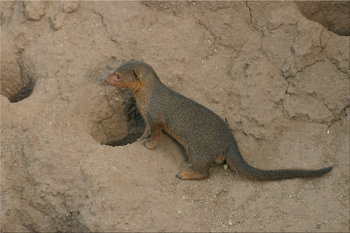 |
| Egyptian geese | Dwarf mongoose |
All these animals, from the largest to the smallest, don't pay the noisy diesel powered safari vehicles the slightest heed. I am guessing they have lived their entire lives with this traffic, and classify it in the same category as an elephant: Big, can't eat it, doesn't try to eat you and there's nothing you can do about it, so you might as well ignore it. This goes for the elephants themselves too: They could easily chase off something the size of a land rover if they wanted to, but they don't seem at all bothered by us.
I find the safari vehicles as photogenic as anything here, and photograph them as well. Pu is ecstatic about the woods. The weather is beautiful, and as usual there are no mosquitoes to speak of.
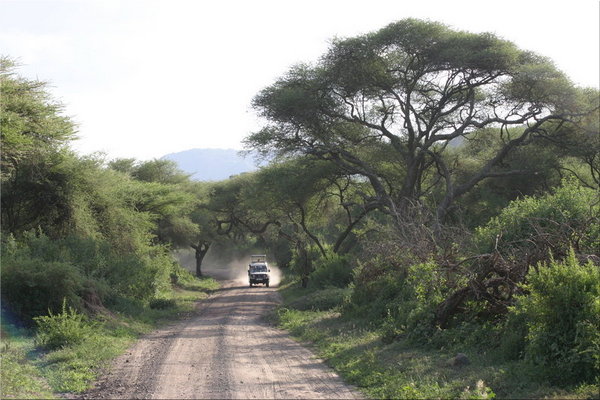
|
|
The land rover in its natural habitat
|
Up to now, we have done pretty well with our digital camera storage. We have enough memory for about 1000 pictures each, but now, in two hours we've fired off about 200 and some serious editing is in order. Fortunately the batteries on the digital SLRs last a long time. The cheap 55-200mm zoom lens that I've bought (equivalent to 90-320mm on a 35mm film camera) is working out very well, except that I'm having to set the camera to ISO 400 and thus getting slightly grainy pictures.
Thanks go to Caroline for remembering what all the animals are called and helping me (three weeks later) correctly caption the photos in this trip report. Note that there are a huge number of animal photos on each of the safari days, all of which you can see by following the "All pictures" links at the bottom of each page.
Just before the sun goes down, we head back to the campground. Not only is this like a European campground, but the couple at the table next to ours with Courtney and Julia (who keep crossing our path) are Germans. It is the girl's birthday, and there is enough cake for all of us to get some. There seem to be a lot of other Germans camped here too.
Dinner is excellent. I make several trips to the grocery store just outside the campground gate to get soda pop. We sit around talking until long after dark, me in German with the German couple after the others wander off. Eventually I follow some intriguing drumming noises and find the campground's bar, where a trio of percussionists are making a compelling noise with a mostly white audience watching in respectful silence. I do a little bootleg recording with my digital recorder in plain sight. Nobody pays it the slightest heed, since small, shiny tech gadgets being fiddled with and sitting on a chair armrest are usually cell phones.
A group of men and women who have been sitting in front of the building now come in, and they turn out to be dancers. Really good dancers. I watch what remains of the show, and it is excellent. For the final number, the dancers all drag audience members onto the dance floor. I resist. When it is finished, I withdraw into the land rover with the recorder to take some notes away from mosquitoes, and then go to bed. It is quite hot all night and I don't sleep well.
While the breakfast stuff is cleared away, I use the spare time I have to take a shower. I correctly assume that there will not be showers at the next two nights' campouts. Andrew, Pu, Vinh and I are in the land rover driven by Robinson, and we go ahead. In the town that the campground is in, the highway has, at perhaps 100m intervals, three sharp speed bumps, then a big one, then a crosswalk, then another big one and three sharp ones again. Robinson crosses these at 10km/h at most. This is the norm in every small town on the highways around here. I guess the cops don't have to bother much with speed limit enforcement.
Past the park, we go up the steep escarpment. Many people are seen pushing their single-speed bicycles up the hill. Seeing the curvy road with its perfect pavement, Andrew remarks that he could have some fun with his S2000 here. After a scenery stop at the top of the climb, we continue into higher ground around 5000 feet elevation. It is very fertile here. The reddish soil, the rolling hills and the active agriculture make the landscape very pretty. Even when there is a mix of pasture and crops, there are no fences anywhere, because each flock of animals is always watched by someone.
We stop for fuel in the town of Karatu. The price of Ksh 900 per litre of diesel is written on the pump housing in crayon; the actual tallying mechanism does not work. While we get fuel, an alarmingly pretty girl is trying to sell us handmade baskets. It is hard to watch her and not smile back, but of course doing so implies that you want to buy something. On the way through town, we note that there is an internet cafe here.
In the distance, high ground crowned by clouds is the rim of Ngorongoro Crater. The perfect road continues right up to the entrance station to the conservation area, where there is a construction zone and then only dirt road. At the entrance station, we go into the visitor centre and examine relief models of the crater while Robinson does paperwork. The other vehicle, driven by Issa and containing Peter, Caroline, Caroline, Yi and David the cook, catches up to us here. I watch some baboons but they are shy and disappear into the bushes if I get closer than 10m.
Formalities completed, we continue steeply uphill for quite some time, until the crater rim at about 8000 feet elevation, where we stop at a scenic overlook.

|
|
Ngorongoro Crater
|
We have to go along the rim for quite a distance before we reach the Simba campsite where we will spend the night. While the bags are unloaded and the trailer is unhitched, we watch some large Marabou storks. Then the safari roofs are opened up, and we continue around the crater rim to the descent road, where there is a steel gate and an armed ranger post and our paperwork is checked. I later see that at least one species of animal made nearly extinct by poachers (the white rhino) can roam in peace in this crater, perhaps because it is easy to keep the poachers out. The only way in and out is on the descent and ascent roads, respectively.
The descent road is bumpy and only one lane wide. There are fresh imprints of bulldozer treads where a landslide was cleared away. The bulldozer is parked by the road, down in the crater. We pass a Masai herdsman and his cattle. We are told that the Masai freely roam these conservation areas and don't interfere with the wild animals, and the lions don't interfere with their cows (having learned that the sharp end of a spear awaits them if they try anything - but at least the Masai teenagers don't hunt lions as part of their manhood rites any more).
On the crater floor, the first stop is the yellow acacia woods, where the elephants hang out. The woods have a slightly shopworn look to them for this reason, but are very beautiful nonetheless. We stop right by a very large bull elephant who ignores us.
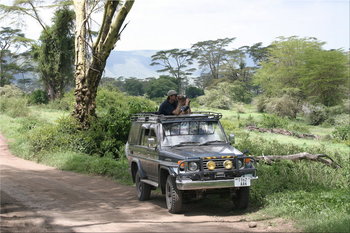 |
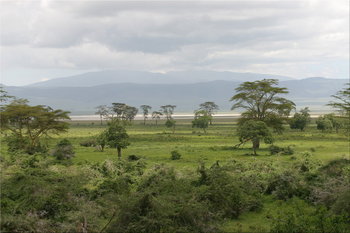 |
| Elephant spotting | Very pretty elephant habitat |
We make many stops to marvel at the animals seen in the following pictures.
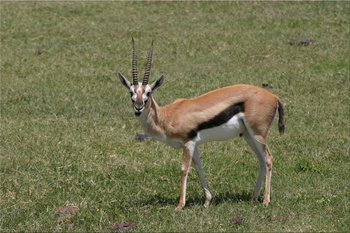 |
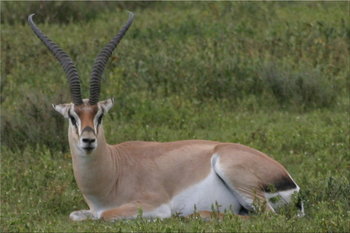 |
| Thomson's Gazelle | Grant's Gazelle |
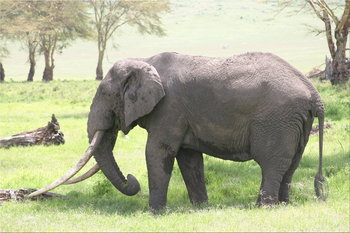 |
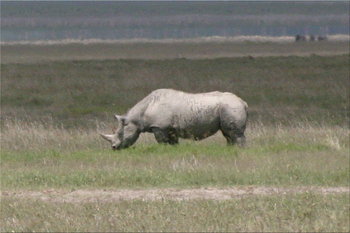 |
| Mature bull elephant | White rhinoceros |
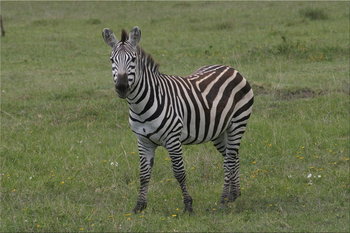 |
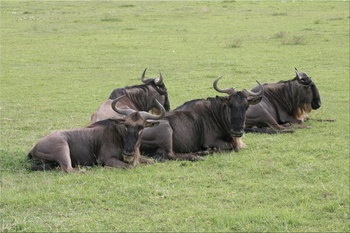 |
| Zebra | Wildebeest (aka Gnu) |
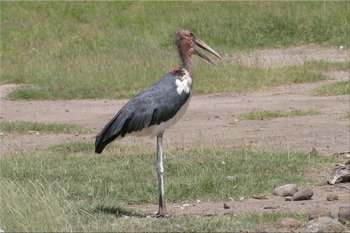 |
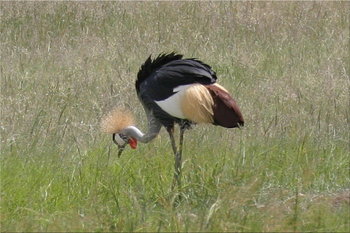 |
| Marabou stork | East African Crowned Crane |
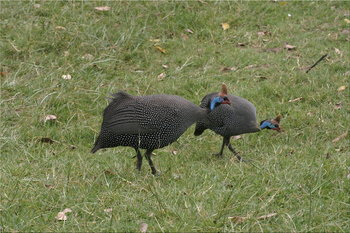 |
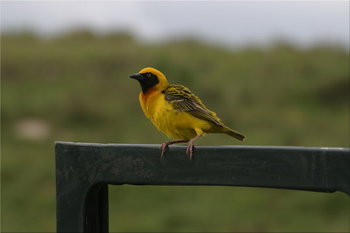 |
| Guinea fowl | Baglafetch Weaver |
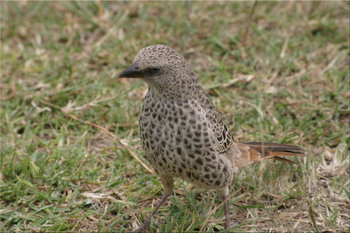 |
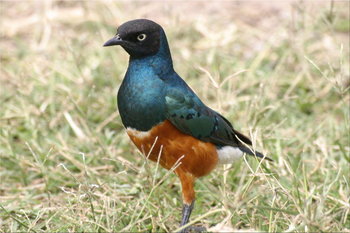 |
| Rufous-tailed Weaver | Superb Starling |
Driving around again after lunch, we spy some giant "Eland" antelopes in the distance. Note the size compared to the zebras in the foreground!
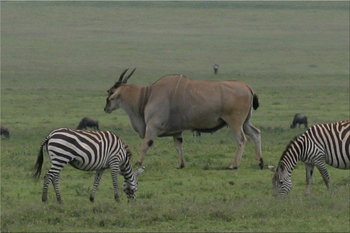 |
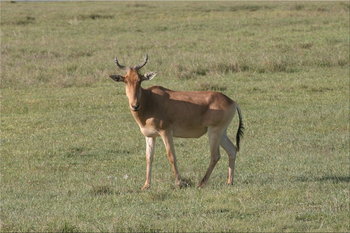 |
| Full-grown eland antelope | Hartebeest |
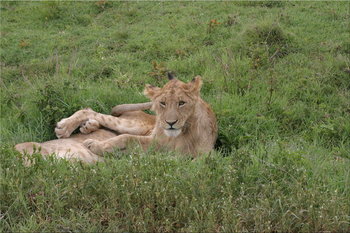 |
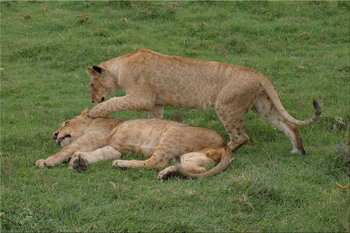 |
| Two lion cubs | Two more lion cubs |
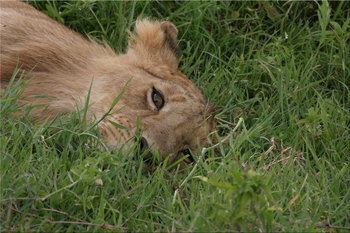 |
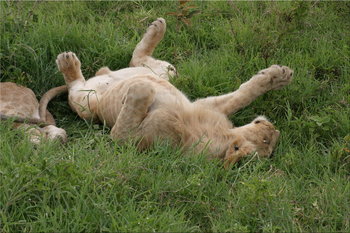 |
| Hello kitty! | This cat is not concerned about much. |
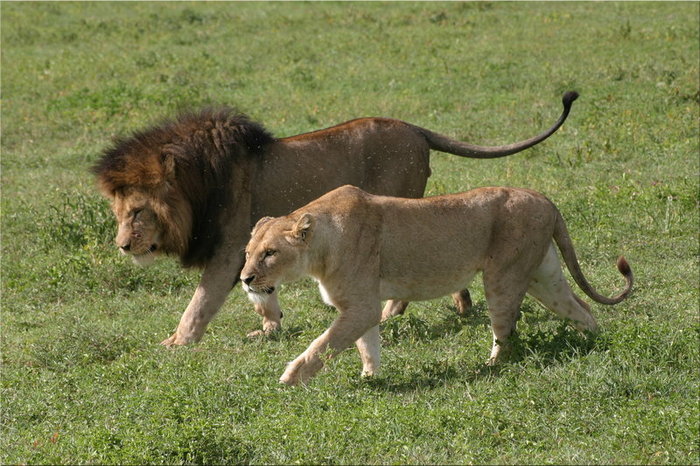
|
|
Adult lion couple
|
Another reminder that these are only the best of hundreds of animal pictures on file here. Follow the "All pictures" link at the bottom of the page to see the rest of them. Also, the originals are 6 megapixel images suitable for printing up to 18x12" size. If you want one, let me know what for.
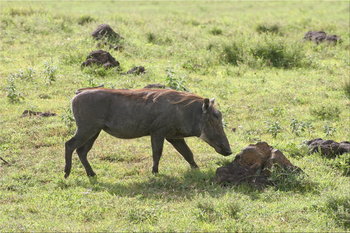 |
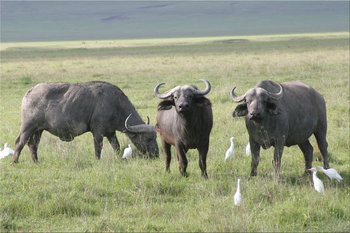 |
| Wart hog | Water buffalo |
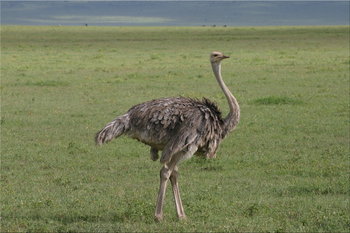 |
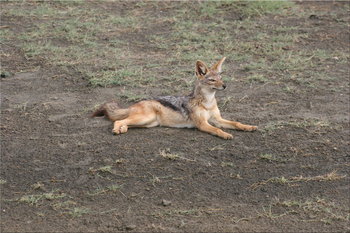 |
| Ostrich (female) | Jackal (photo by Andrew) |
After hours of driving around, we are all happily content with the day's animal watching, and the safari vehicles all converge on the ascent road as the park gates will close soon. We stop for another brief look down into the crater.
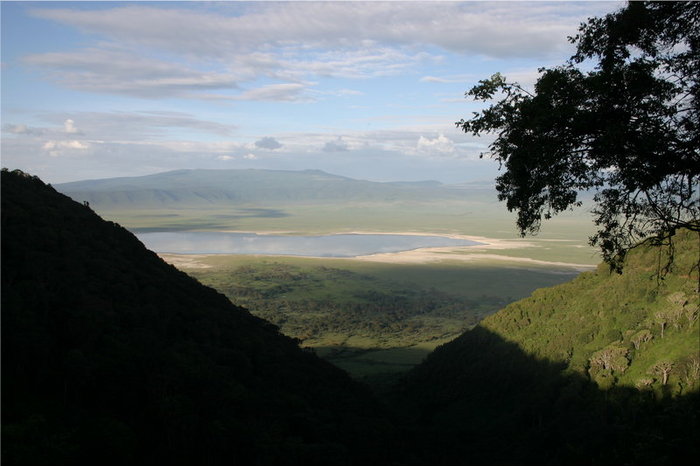
|
|
Last look into Ngorongoro Crater from the ascent road
|
Then it is back to Simba campsite, which is the prettiest campground I've ever stayed in. A huge tree overshadows the meadow where tents are pitched, and you can see down into the crater. After dinner, we head to our tents in the dark, and I hear a munching noise and follow it. In the faint light of my headlamp, I see a huge bull bovine stop munching and stare back at me. Now, bull bovines are not known for their gentle tempers, and buffalo particularly not so, so I give up my investigation and prepare to go into my tent. Just then, Pu arrives, very agitated: "There's a big animal eating my tent! Pu had pitched his tent far from everyone else's for nighttime peace. Now what. We go into the cookhouse, and eventually come back with an armed ranger, our driver Robinson, and another guy. When they see what the trouble is, they have a good laugh. Apparently these particular buffaloes graze here all the time and never bother anyone. But Pu moves his (uneaten) tent to be with everyone else. In the night, I hear the buffaloes munching away between the tents anyway.
At this elevation, the climate is very nice and we sleep well.
But first things first. Breakfast at Simba campsite, then we drive off the rim of the Ngorongoro Crater, downward through rolling hills, I am guessing off the other side of the "Great Rift" ripples in the tectonic plate. Masai villages dot the landscape. There are two kinds of these: The ones high up on a hill with only footpaths leading to them, and the ones with an "in" road and an "out road". These latter cater to tourists.
Many, many Masai are seen by the roadside. Teenage boys have white patterns on their faces and wear plain dark robes and gold medallions. We are told that this means they have just been through their circumcision / manhood rite ceremony. Why this involves standing by the road side and rocking back and forth as cars go by is beyond me. Perhaps it is just to attract photography, for which they can then ask for money. Generally we keep our cameras stowed and just wave in a friendly fashion, and most folks wave back.
The Serengeti has legendarily large herds of zebras, wildebeest and other herbivores who migrate seasonally to follow the water and fresh grass. However, today the plain seems largely deserted.
I have done no advance reading about this place, so I have no idea what this Olduvai Gorge museum is, where stop.

|
|
Olduvai Gorge. Cradle of Mankind?
|
Well, as I soon learn, this gorge was formed by water erosion, because of a slope in the landscape because of the same tectonic upheavals that formed Ngorongoro Crater. And this slot cut into the land laid bare all kinds of ancient stone tools and fossilized hominid and animal remains. And eventually, the Leakey family of archaeologists discovered some 3.6 million year old hominid footprints, preserved in hardened volcanic mud. We admire a replica of these footprints. The originals are about 40km up the gorge, reburied in a way that best preserves them for the future. A Masai herder, meanwhile, is driving his cattle through the gorge.
After we've read all the signs and listened to the talk, we continue driving across the flat plain. A distant hill, which at first seems to float in water due to heat reflections off the grassland, grows nearer. It is the site of the entrance station to Serengeti National Park (until this point we were in the Ngorongoro Preservation Area). We note that the admission fee is US $30 per person for foreigners, and Tsh 1500 (about US $1.50) for Tanzanians. This is perfectly fair given the difference in incomes.
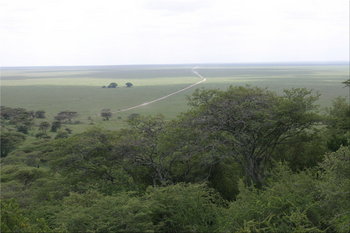 |
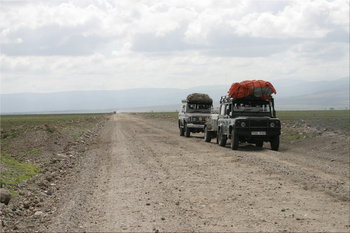 |
| Serengeti plain from a hilltop | Safari vehicles on the Serengeti Plain |
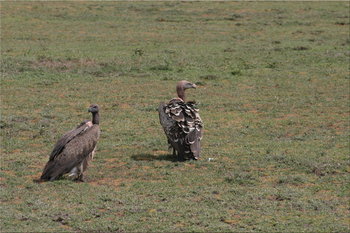 |
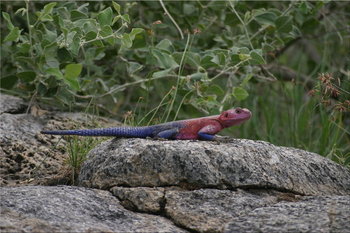 |
| Ruppel's Griffon Vultures | Red Headed Rock Agama (Caroline, what would I do without you?) |
A surefire hit with any safari tourists is a lively hippo pool, and the one we now drive to is very lively, full of splashing and puffing and grunting noises and with an unbelievable number of animals in the water. Robinson says that it is perfectly fine to sit right by the water's edge, so we do that and take lots of pictures. In the excitement, I don't even notice the crocodile (Crocodylus Niloticus - thanks Caroline) nearby, but Andrew gets a photo.
So, anyway, hippos have to stay in the water during the day, because otherwise the sunlight would dry out their skin and dehydrate them. In the night, they come out to forage. We can't tell whether the silliness in the water is friendly play or grumpiness, but it is entertaining.
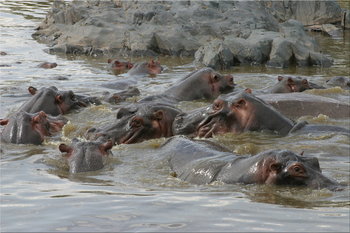 |
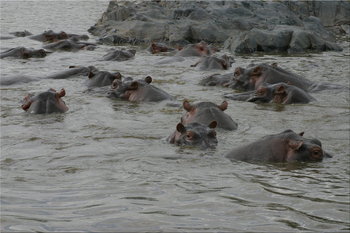 |
| Quick: How many hippopotami in this picture? | Or in this one? |
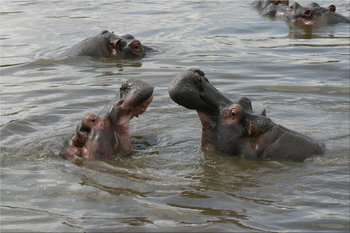 |
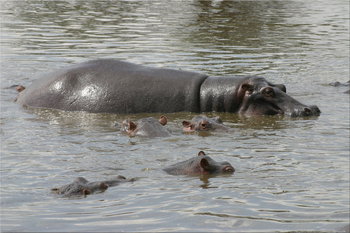 |
| Friendly kiss or grumpy argument? | I'm big, don't mess with me |
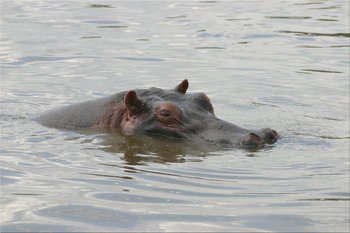 |
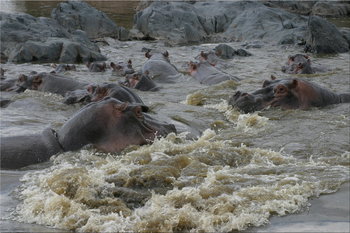 |
| Hi there | Missed an action shot, as usual |
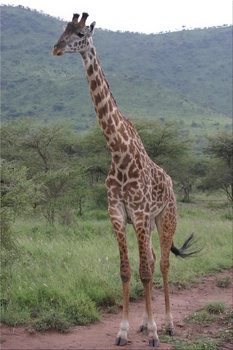 |
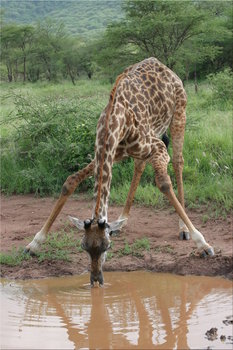 |
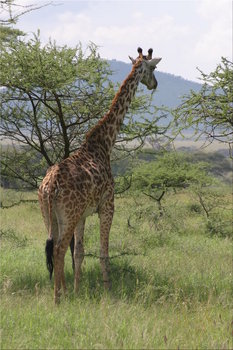 |
| Do I feel safe with these tourists around? | I guess so. Slurp, slurp. | Another giraffe, browsing |
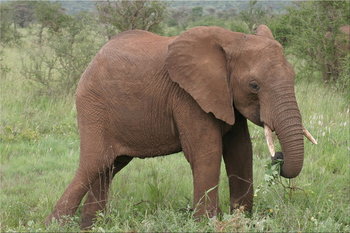 |
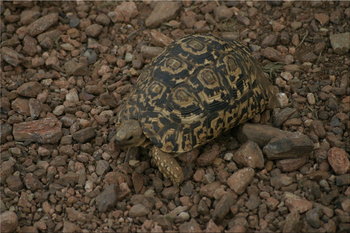 |
| Yet another elephant | Leopard tortoise, showing effective camouflage |
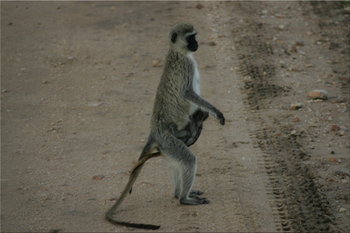 |
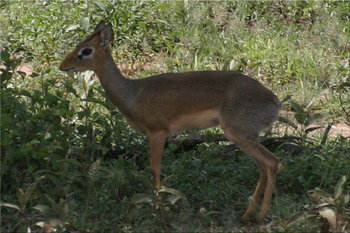 |
| Velvet monkey with baby | Dik Dik: Miniature antelope for your purse |
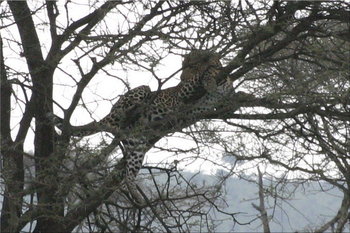 |
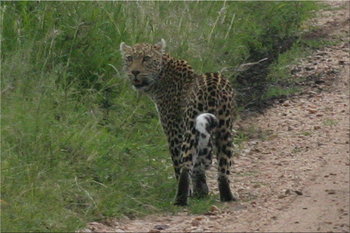 |
| Leopard in a tree, from maybe 150m away | A second leopard |
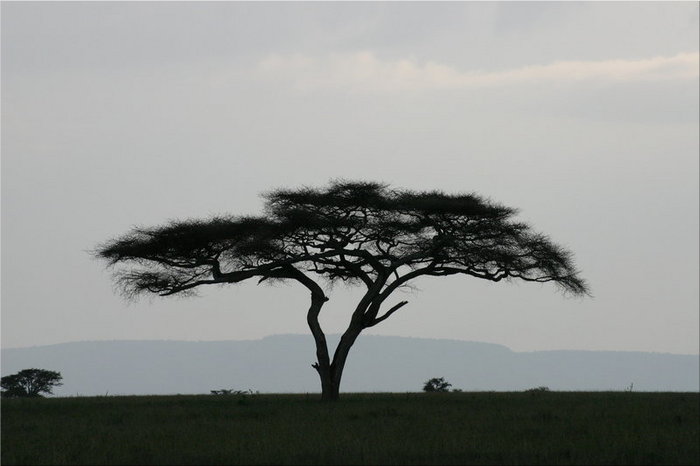
|
|
Nicely silhouetted acacia tree
|
Issa says that we have seen all of the "big 5" animals: Lion, leopard, buffalo, rhinoceros and elephant. They have the distinction of being the most dangerous to human hunters. The only thing we really missed out on is the cheetah.
Overnight there is a thunderstorm.
We reach the airport by about 2pm. From the highway to the terminal building, the road is a dusty dirt road as bumpy as they come, and I notice that the runway is unfenced on one side so any goat could wander onto it.
We say goodbye to our driver Robinson, and I slip him the tip from our group and also give him a big bag full of Gatorade, granola bars, pens, pencils and so on, to distribute to others as he sees fit. I particularly stress that my Petzl Tikka Plus headlamp is for Luckas, who guided us up the mountain with the dimmest of flashlights, and was so helpful to me when altitude sickness overcame me (back in Ottawa I will promptly buy a new Tikka Plus, of course).
The terminal building is small and simple. Bags are carried by hand (we are each dinged around $20 for overweight baggage; nobody had mentioned the 20kg limit) and boarding passes are handwritten. There is a single baggage screening machine, which is used both for checked luggage and for carry-on stuff.
The airplane is a clean, modern ATR-42 twin turboprop. The staff are crisply uniformed, the service is good; the "Precision Airlines" name seems deserved (this is our first experience with an African airline). The pilot announces that the takeoff will be bumpy, since the last part of the runway is unpaved due to construction, but not to worry, the plane is built for rough field operation.
During the flight, I am skimming a Zanzibar guidebook that I borrowed from a woman named Diane who is also on the flight. I know nothing about Zanzibar, and I'm a bit worried that the others want to stay at some beach hotel 10km out of town, when exploring the town itself is plainly where it's at. I use my digital camera to make legible copies of some map pages and a list of affordable in-town hotels. Andrew and Caroline peer out the windows on the left side, hoping for a glimpse of Kilimanjaro, but our flight path goes almost directly away from it so nothing is seen.
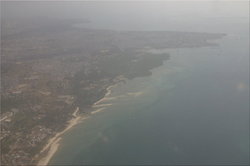
|
|
Hazy view of Zanzibar Town from the air
|
The airport is quiet, and soon we are the only ones left in the arrival hall. Everyone except Yi and myself obtains U.S. cash at a money change counter where they take credit cards, but charge a 6% commission plus a $2 service charge (I assume I can do better in town. This will turn out to be wrong). I try to find out again why we are going to this Imani Beach Villa instead of to a cheaper and more central place in town. Andrew doesn't mention that this was no arbitrary pick; that this was recommended to him and he's checked it out on the internet.
I wander out and ask what a minivan to our hotel (almost 20km away) would cost for the five of us with our bags. I am quoted $20, which seems very reasonable so I don't haggle (it turns out $10 would have been possible).
And so we are dumped at our beach hotel. It turns out that we are in the "annex" which is an ordinary house about half a kilometer up the beach, which Bruce the hotelier just recently leased. We walk there on the beach while Bruce goes in the taxi.
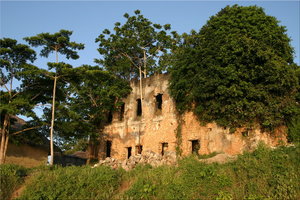
|
|
The ruined sultan's palace next door
|
Bruce is a California dropout. In the offseason, he lives in Venice and teaches film script writing at the university there. The rest of the time he runs his hotel here in Zanzibar.
On the way over, I noticed an intriguingly ruined building next door. Bruce explains that this was a sultan's palace. I grab my camera and wander in there, immediately attracting the attention of some local kids who try to talk to me. I go into the structure, and find that the stairs are intact right to the top floor. I'm barefoot, and nowhere is there any broken glass or other foot hazards.
I ask Bruce what is scary here. He says not to worry, no hazards in the ocean, and you can go into town at any time of day or night and not worry about being mugged. I like it here already.
So I go into the water which is clear and lukewarm, and swim, and try to make conversation with a friendly local kid whose name is approximately "Sabre". The sun sets, gloriously. Andrew and Caroline are on the beach and ask me what I'm doing. "Everyone is always telling me to live a little. Well, I'm living a little".
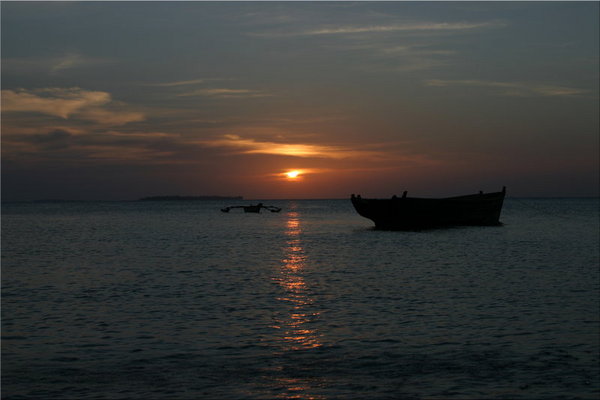
|
|
Arrived in paradise: First sunset in Zanzibar
|
I have to come out eventually and shower, so we can go to dinner. We walk on the beach back to the main place. Little crabs with (in the headlamp light) glowing eyes scurry around on the sand. At the main hotel, the eating area consists of low tables, and cushions you sit on. You go barefoot. Motown music comes out of computer speakers. Backlit drapery hangs from the ceiling. What kind of style is this? Southern California Eclectic, is the best guess we come up with (the hotel's web site says it's Moorish).
A large wedding party fills most of the dining area. While they eat, we wait for our food. It takes, I think an hour and a half for the appetizers to come. The food is excellent.
When, later, we wander back along the beach, the moon is just setting over the water. I look upward as I walk, and I see the tops of the tall palm trees against the starry southern sky, and it is warm and humid, and the waves lap gently on the beach, and the distant bass thump of a bar blends in as we go past the ruined Sultan's palace and step around the wooden outrigger fishing boats that haven't changed in 500 years, and greet our Masai night guard, and I sit out on the beach and I just can't believe that I am here. What an amazing world we live in. I hope someone will show me the Southern Cross before I go back home.
For tonight, Andrew and Peter and I have the air-conditioned bedroom, and I sleep like a log.
To get into town, Bruce has explained that we can be normal tourists and take a taxi, or, for 20 cents each, we can get up close and personal with the locals on the public transit system. This we must try.
Public transit here is the "Dala Dala" system. A Dala Dala is a pickup truck (usually Toyota) with a "U" of benches in the back, and a roof. A conductor stands on the back running board, and solicits customers, which are packed in until the vehicle has the legal maximum of 20 passengers in the back, or rather, until it is no longer humanly possible to squeeze anyone else in, and often two passengers in the cab as well. There is an electrical signal button which is never used; instead the conductor bangs on the metal tubing of the superstructure with coins; two bangs means go, three bangs means stop, I think.

|
|
Several Dala Dalas
|
The pace is frantic, with the vehicle usually well under way before the conductor hops back on, with speeds of I think 80km/h reached between stops. There are Dala Dalas everywhere, all packed full of passengers. Cool young dudes with sunglasses, devout robed muslims, housewives with children, habited nuns, you name it. The longest we ever wait for one is two minutes, with 30 seconds being more typical. Each vehicle is operated, I think, as a private enterprise so they compete with each other for passengers, but there is no shortage of customers. A quintet of white tourists draws some surprised glances. But that's OK with us. I love it.
The Dala Dalas converge on their downtown terminus, which is a dusty lot across from the central market.
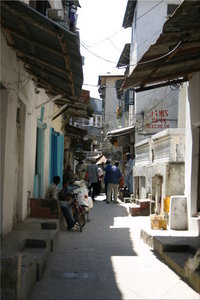
|
|
A typical alley in Stone Town
|
Stone Town is a world heritage site. Tourist literature emphasizes the crisp, picturesque white buildings. This is the first place we see in Africa that has an architectural history.
In real life though, this is no preserved museum piece. It is hot and it smells, and the buildings are crumbling. Lots of people live here. The tourism industry is still new, not yet in high gear. Restaurants are few, the hotels are hard to find. The main waterfront park is full of dead grass and garbage. All this is quite a culture shock, though I will find that after a couple of days here, one starts to tune it out, and notice more of the nice stuff, the picturesque little alleys, the interesting angles, the way the late afternoon sunlight plays on a whitewashed wall.
I love diving into the maze of Stone Town with just a general direction in mind, and wandering down alleys which, hopefully, I have not been in before. With enough wandering you discover everything. A store that actually has Hostess Pringles (Andrew's favourite potato chips). An actual North American style supermarket. A video arcade. Internet places charging $1/hour. Islamic places of prayer. Woodwork shops. An auto body shop. Schools. A guy cranking sugarcane through a metal press to produce glasses of a cloudy beverage that the locals drink, with flies buzzing around. Really eclectic hotels. The only trouble is finding a given place again later.
We walk down the tourist alleys, where every store is a curio shop full of carvings, Masai beadwork, paintings and banana leaf pictures. We emerge on the waterfront. Anywhere cars can go, we can't walk 100 yards without someone offering us a taxi ride.
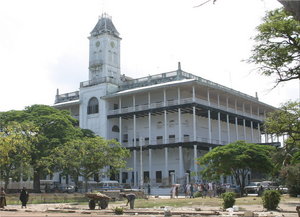
|
|
The House of Wonders
|
The House of Wonders is the grandest building in all of Zanzibar. It was designed in 1883 by a Scottish marine engineer, and has been used since then as an administrative center by the British when they ruled here, and as a palace by a couple of sultans. Currently, we find, it is used as the national museum. It costs $3 per person to get in. So used am I to haggling by now that without even thinking I ask for a group rate for 5 people. We are let in for the price of four.
The museum is not bad inside. It has, as its centerpiece, an old wooden Dhow (the local kind of sailboat) that is constructed without nails, the planks actually being sewn to the ribs with ropes. Apparently nails were not used until the Europeans came here. In a corner, there is a small outrigger fishing boat. It is virtually identical to the boats parked on the beach in front of our hotel, which are in current use. Boat construction has not really changed here in hundreds of years.
We eventually end up on the balcony, on which one can walk all around the building, and admire the view from there. Andrew spots a Christian church in the distance, which we will later try to find, unsuccessfully, in the maze of streets.
The only bad thing about the House of Wonders is the washrooms, which don't seem to get much maintenance.
After we finish here, we stop for ice cream at the Tembo hotel, and then find our way by trial and error back through Stone Town to the Dala Dala terminus, where the others go off to the hotel, but I wander off again in a different direction. I want to see the harbour.
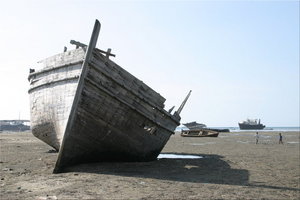
|
|
On the tide flat
|
The tidal flat is great. I take pictures all over, and initially intend to walk north until I find a good way back onto safe ground. But several people shout to me that it is not safe. I figure as long as they continue hammering on their boats, I'm probably OK, but I eventually retrace my steps out the way I came. About an hour later, I find that the tide has risen enough so that the flat would now be flooded, not deeply mind you, but one's feet would get wet.
I pass a boat builder's encampment. Here, Dhows are constructed by methods unchanged for centuries. Ribs are being whittled out of crooked wood with axes. Two wiry men in their 50s are whipsawing a log into planks by hand. I am not sure if I would cause offense by taking a photo, so I miss a great picture. Another man is working on a sail.
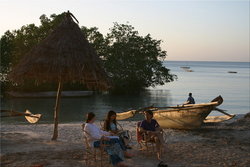
|
|
Beach Paradise
|
Then I catch a passing Dala Dala and am whisked back to the hotel. There, I once again go swimming in the beautiful, lukewarm clear Indian Ocean. I intend to get out of the water in time to photograph the sunset, but I swim too slowly and miss it. In the evening, we go to eat at the hotel restaurant again. The service is even slower than last time, even though we (and Bruce and a special guest from Italy) are the only customers.
About the last thing we do today is to try to photograph the moonset. Once again, I sleep like a log.
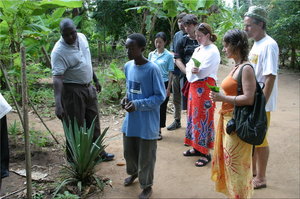
|
|
On Spice Tour with Rambo, the multilingual guide
|
We see cinnamon (which is actually the bark of the cinnamon tree, which is cut down to harvest the bark and then used for firewood), the "lipstick tree" whose seeds are intensely red and used for their colour, aloe vera, sisal (used to make tequila), ginger, tumeric, breadfruit, cardamon, the "Dorian" tree (whose fruits taste great but smell so bad that it is illegal to eat them in public in Singapore), lemongrass, cassava, pineaples, mango trees, cloves (the "King of the spices" here -- cinnamon is the queen), limes, passion fruit, guava, vanilla (a creeping vine), nutmeg, and black pepper. Not all of these are spices of course.
Palm trees are everywhere. The teenage kid takes off his shoes, ties his feet together with some plant fibers, and shimmies up a palm tree effortlessly. He drops down several coconuts which are still green, and then expertly cuts them open and hands them around. The coconuts are hollow and full of water. The water has a very slight coconut flavour. On the inside of the nut, there is about 1/4" of the white substance that we associate with coconuts. When a coconut is ripe, the outside becomes brown and fibrous. We see these coconuts being processed. A man impales them on a metal spike, rips apart the husk, and tosses aside the core, which is maybe 4" in diameter. We have seen those same cores sold at market in town.
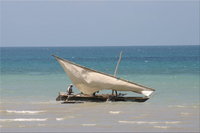
|
|
Almost got a picture of a Dhow under sail
|
We are out of cash. To pay for the last night's hotel and our airport departure taxes, we need another $200. It is my turn to get some. Bruce assures me that the money changers at the airport are as good a deal as anyone in town, and it is Sunday and the places in town would be closed. So I resolve to ride the Dala Dala to the airport.
At the central terminus, I just shout "Airport?" and am directed onto a particular vehicle, which indeed zooms off in the right direction. But after a while, there seems growing unease with me pointing at the airport on the map, and I am given to understand that I should be on another line which branches off on another road. So I get off and wander over there, but no Dala Dala comes. Instead I am collared by a kid who wants to give me a taxi ride. Sure, why not. Even though I could walk to the airport from here, I agree to be driven there for $3. Almost immediately, the kid fends off another hopeful taxi driver who has stopped. I am led across a vacant lot to the most decrepit Toyota you ever did see (which has long ago shed its muffler) and the kid says something about OPEC. I assume I didn't hear right, but... we drive up to a small boy holding a 2L plastic jug and sure enough, the contents of this jug are funnelled into the gas tank. Then off to the airport, where the kid has only a 1000 shilling note to his name, so he ends up getting $4 because I don't have anything smaller than $5. I wish him luck and tell him to get some more OPEC.
The arrivals hall is deserted as usual. Only one of three money changers is open, and he is not the one who takes credit cards. Indeed, the one who does has a sign saying closed on Sunday. But never fear, they say he'll be there in a few minutes. Meanwhile I wander out the other side of the building and watch the planes.
I finally get my $200, and walk back out front, where I am accosted first by the official taxi drivers, then the second tier gypsy cab types 20m further away. I'm walking, I say. After all, it's only a few hundred meters to where the Dala Dala line (the one I was on, which was the right one after all) passes. The offered price goes from $5, to $4, to $3 for a ride downtown. Oh what the heck. But this time I want change for a $5! A man helpfully offers to change my money and hands me back three $1 bills and a $2. I've never seen one of these, and pocket it to keep.
So I get into an ancient Mercedes owned by a guy who speaks pretty good English. The first stop is, you guessed it, a gas station, where my $3 are handed over and 3.21 litres of gasoline are put into the car. This is not enough to budge the gas gauge off "empty" or extinguish the warning light. The driver says hopefully there are no cops because he is not a licenced taxi. I offer to duck if any are in sight. I ask to be dropped a little ways short of downtown because I want to walk up the seashore and explore some more.
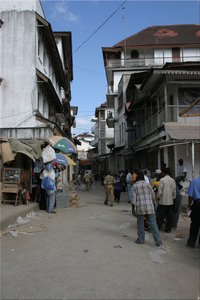
|
|
Typical street scene in central Zanzibar Town
|
Walking onward, I pass an Indian and then an Italian restaurant that look pretty good (both very close to the ritziest hotel I've seen, the Serena Inn), and then emerge in the heart of Stone Town again. I now have a mind to buy some banana leaf pictures, and earnestly look at a couple hundred to pick out four that I like. Haggling for the price is done with a calculator. It starts at $28, and I start at $10. We meet at $15, which is probably a few dollars too high because I didn't take the penultimate step of walking away and waiting for the seller to catch up with his lowest offer! Another seller gets so excited at having a live customer around (apparently Sunday afternoon at this time of year gets a little slow) that he offers me stuff from other people's booths. I would actually buy a huge packet of saffron offered for $4, but the owner of the booth objects (it is marked at $8).
I pass an internet cafe. The price is 50 cents for half an hour, and the machines are ordinary Windows computers; your money gets you into a room and then you can use them as you please. In the "My Documents" directory there is a Word document which is a letter firing someone from his job for negligence. Instant messaging works too and I manage to chat with a couple of people. My brother Matthias tells me he's just getting ready to go skiing. It is, of course, 8 hours earlier in the day, and the opposite season back home. I compose the fifth and last of my on-the-road emails to friends at home.
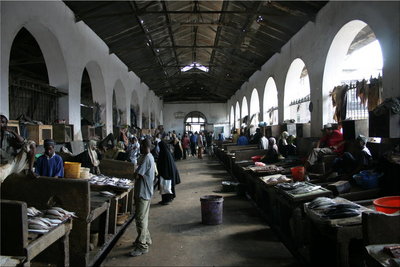
|
|
The Fish Market
|
Back at our beach house, I am thirsty for soda pop, but there is none left in the fridge, so I grab two empties and walk up to the main street. Both the stores where I've usually bought pop are closed, but seeing the empties, a man immediately leads me to another kiosk a little distance away, where sure enough, I get what I want, for 25 cents a bottle as usual. I love drinking pop (Fanta and Sprite usually - this is Coca Cola country) out of the tall, skinny 350ml glass bottles they use here. Few places have cans, and the cans cost much more.
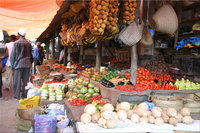
|
|
Vegetable stands in the market
|
Our ride home is a minibus taxi. Without any haggling, the price for the 10km ride for the five of us is $7.
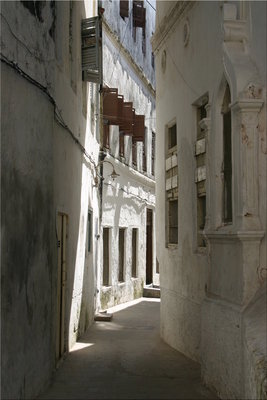
|
|
A particularly nice alley in Stone Town
|
Bruce has offered to have the hotel minibus take us back to the airport for $10. We agressively wave away the tip-hungry porters homing in on our bags, and carry them ourselves for the 20m to the checkin counter. Our flight this time is on Kenya Airways in an older (but clean) Boeing 727-200. The pilot announces that those on the left side of the plane will see Mt. Kilimanjaro as we will fly right by it. So that, of course, is where I sit, but for viewing Zanzibar it is the wrong side and I don't see Stone Town, or Fuji Beach where our hotel is. We do, indeed, fly right past Kilimanjaro and photograph it. I am a happy camper because the flight serves lunch, and when I asked for a vodka and orange juice, they brought me two.
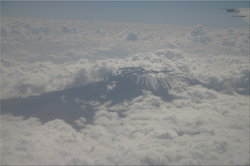
|
|
Kilimanjaro from the air
|
Pu rejoins us now. He has spent an enjoyable three days on the mainland, socializing with the family of David (our cook on the safari), staying at the YMCA in Moshi, going on some more tours, and taking the overland bus back to Nairobi (at half price - everything is negotiable here).
The 8.5 hour flight goes quickly. I watch a movie, eat and even sleep a couple of hours. But the stopover in Heathrow is another 9 hours. The others all go into town, but I stay in the terminal building, trying to sleep (using my knapsack as a pillow). By the time we finally arrive in Montreal, it is something like 38 hours since we arrived at Zanzibar airport, and then we are delayed an hour because the baggage conveyor system breaks down.
An icy blast of wind, at -22°C, greets us as we exit the terminal building. I had thoughtfully packed warmer clothing into my knapsack, but it is not warm enough. Welcome home eh?
Shannon and Jenn have come to pick us up. Caroline is going to Ottawa separately and takes several of our bags with her. The remaining bags, and all the people, and Shannon's dogs, fill the van in truly African style. Munching on cheese, crackers, grapes, strawberries, pretzels, champagne and pop that Jenn has brought, we make our merry way back to Ottawa, gushing with stories of our wonderful trip.
* * * The End * * *